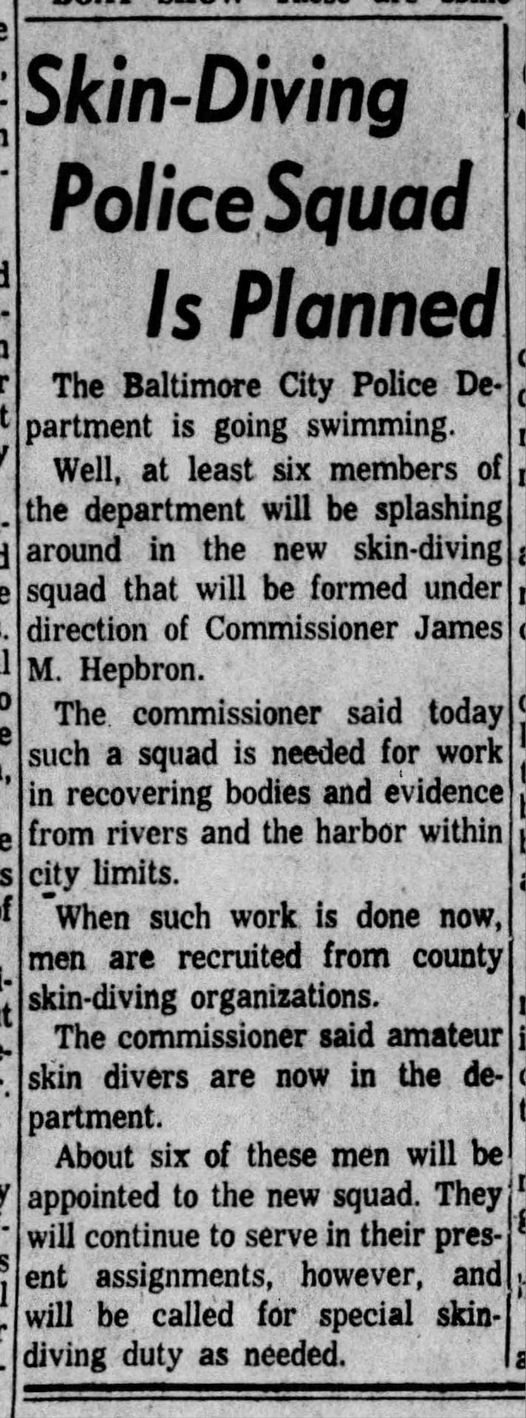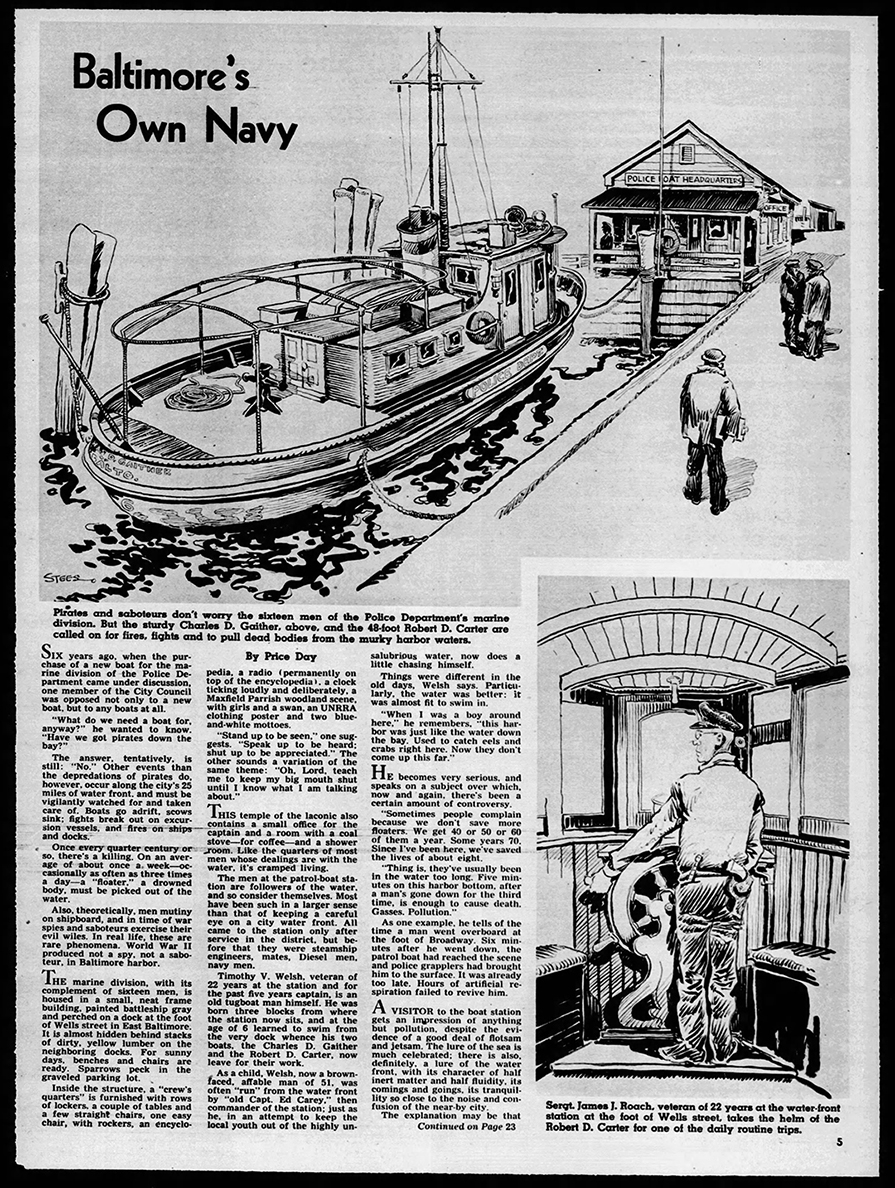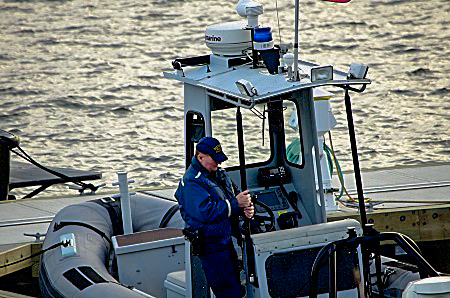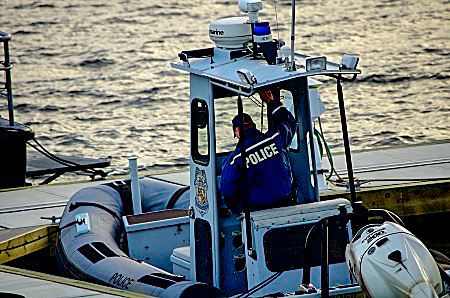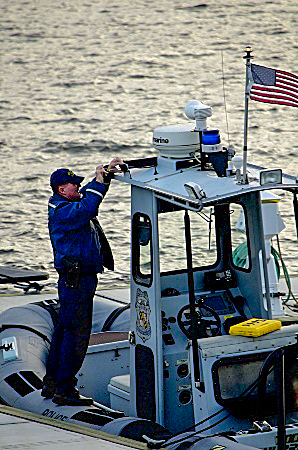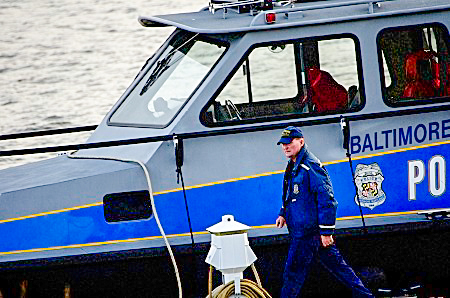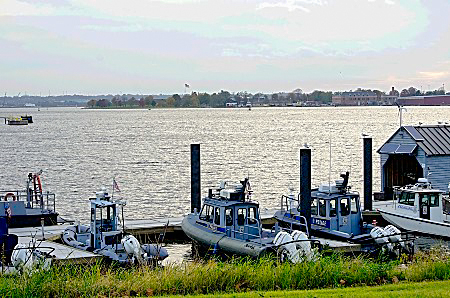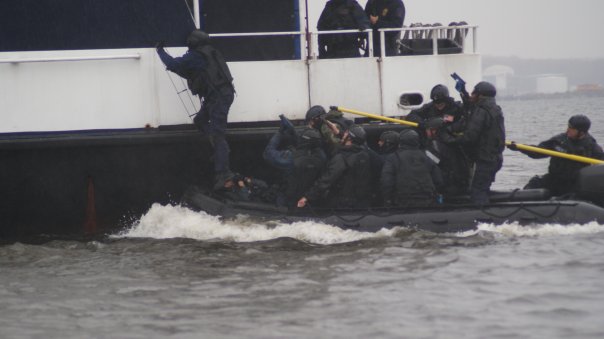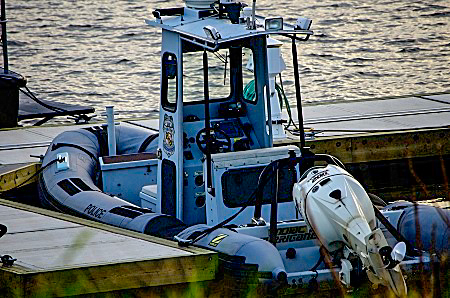Marine Unit
Information from an 1886 Sun Paper article told us of how the department used to rent rowboats to cover their posts in the harbor. In fact, rumor had it that we used four boats, one in the Southern District, one in the Central District, and two for the Eastern District. The theory being the Marine Unit didn't start until much later [1891], and that the District's each took care of harbor patrols from 1860 until that 1891 date. This receipt is for six days of a Southern District Boat rental written out to Marshal Jacob Frey. This shows us that it was the District, not a Marine unit that handled the waters bordering the Southern District, also by giving us a price of $2.50 a week and a total of $2.15 for six days, show it was just one boat at approx. .36 cents a day. If they had more than one boat the price would have been as much as four times higher. This is a great document to help us confirm these dates in history, it also shows this research is much like working a criminal case, which is partially why I enjoy looking up our history so much. A boat livery is a boathouse or dock on a lake or other body of water, where boats are let out for HIRE (rental), usually on an hourly, daily or weekly basis ...
Baltimore City Police Department's
 Marine Unit
Marine Unit
Originated 1860
Formally Founded 31 years later on 10 August 1891
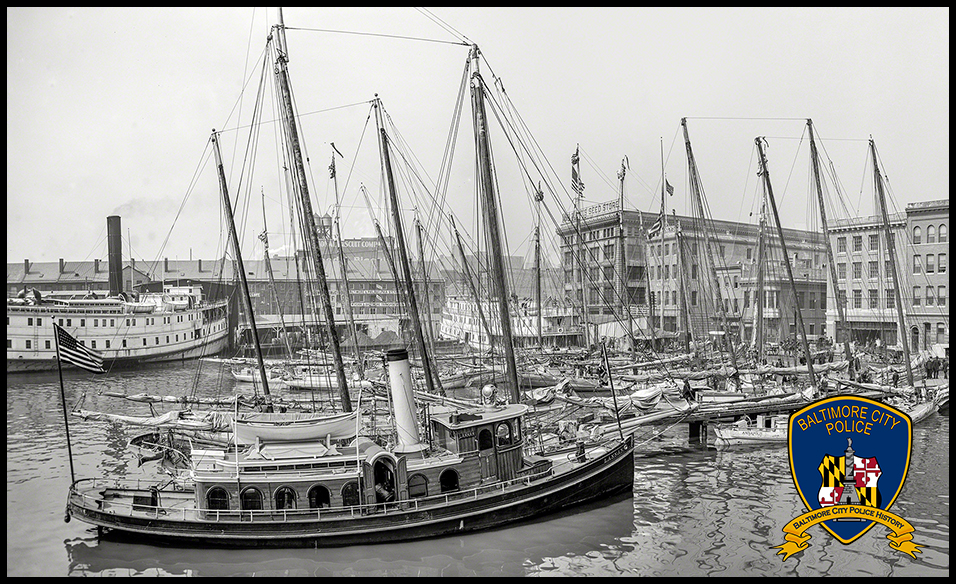 Baltimore's First Police Boat
Baltimore's First Police Boat
Front and Left in this pic is The Lannan
After 31 years of Districts (SD CD and ED) handling the waters
On 10 Aug 1891, we broke away from districts and started
The Baltimore Police Marine Unit
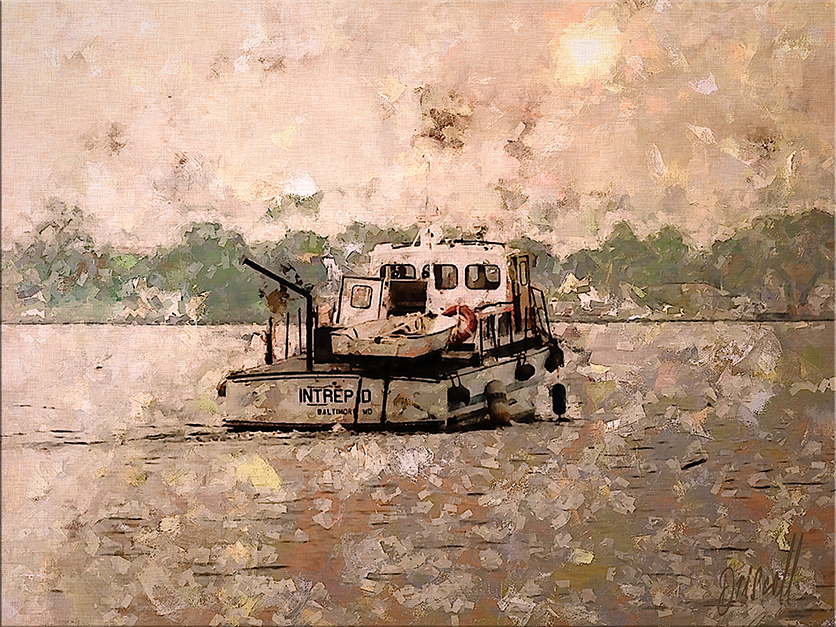
Courtesy Drew Hall
Digital painting of Drew's Pic by Kenny Driscoll
This was the last sail of the Intrepid
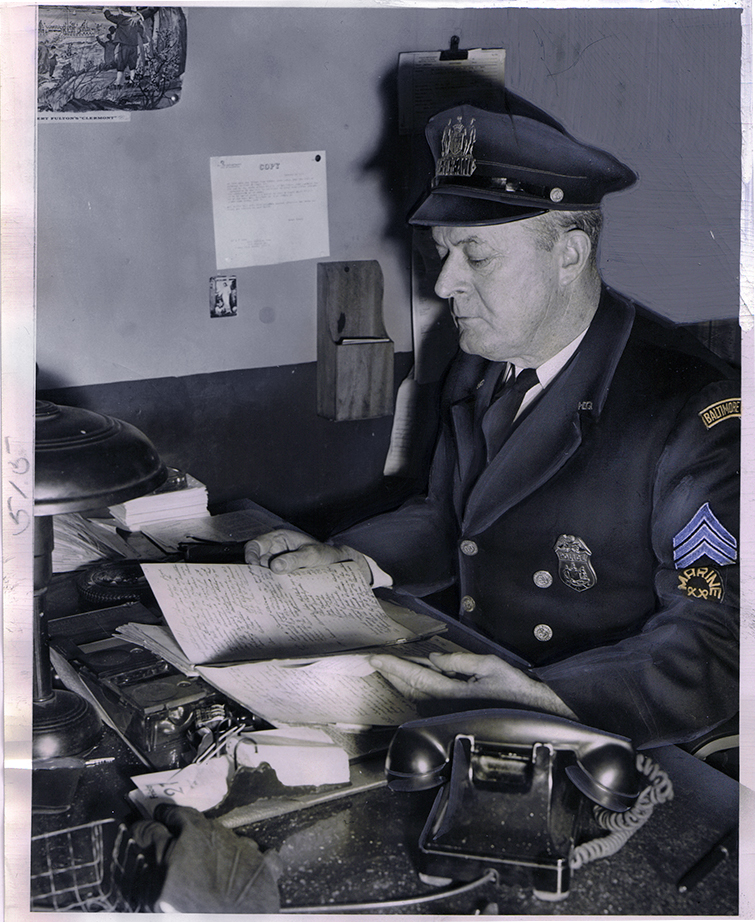
The above photo dated 10 Feb 1956 – Captioned “Sergeant William E. Conroy, in charge of the Marine Division looks over logbook containing 65 years of water-front cases.” – If we subtract 65 years from 10 February 1956, date, we end up at with the year 1891. When we look back at Baltimore Police History, more precisely Baltimore Police Marine Division History, we find that the department's first "Power Boat" of any kind came to us in July of "1891" when we launched, "The Lannan" - See the aforementioned report - POLICE BOAT LANNAN - The Sun (1837-1987); dated 3 July 1891.
![]()
The Launching of the Gaither
Click the above Article or Click HERE
125 Years on the Water
20 May 2016
1860 Maryland State Legislators inform Baltimore City that it is up to the Baltimore Police Department to protect and patrol the waters in and around the inner harbor. The times were very different back then; Just one year before the Civil War Baltimore's harbor was an import-export area that was plagued by thefts, transients, and vagabonds. Given the task of patrolling and protecting these waters would have been no problem for the Baltimore Police Department; after all, they were quite good at their jobs, and at adapting to new law enforcement variations. The only issues we had at the time, was in the ability to patrol the more than 11 square miles of Baltimore's waterways without a boat. We had the manpower; we just didn't have the finances to purchase a powerboat.
Marshal Jacob Frey, was delegated to solve the problem of living up to Maryland Legislators demands. So many times in the past Marshal Frey had done the things needed to bring Baltimore's police to the forefront in law enforcement. Used to work out problems of funding modern police styles, with an old-fashioned police budget, Marshal Frey, had a knack for bringing big budget policing to Baltimore, with minimal sometimes personal funding. Known best for having brought Wagons and Callboxes to Baltimore in 1886; each after having been denied funding for the projects.
So what did he do? Initially, he formulated a system wherein each of the waterfront districts; (three in all) would patrol their portion of the waters by land, and by rowboat. Both Southern and Central Districts each had one skiff while the Eastern District had two. Using the boats to patrol the assigned waters, the districts each had scheduled rounds to make. Much the way a Round Sergeant or Watchman would make timed checks based on a predetermined schedule. The Marshal drew up a plan for each of the three districts having various checkpoints that they were to row out to, then over to another point or two and finally back to where they began. This itinerary was based on the tide, the time of day, and the crime rate, which he used as an indication of when and where they would be most needed. Each taking accountability for their district, their docks, piers, and waterways. The men from these three districts would be assigned to work these boats the way others were assigned a post (bailiwick).
Other than the fact that they still had the problem of lacking funds. Marshal Frey had everything worked out; some say this is where the Marshal worked best. But Frey was more than just someone that could work out budgeting and scheduling dilemmas; he was one of our department's first heroes.
He approached various businesses and pier owners, explaining the benefits they would enjoy by not only having police patrolling the waterways but by also having them launch from their pier. He didn't promise individual or special attention; he let it be known they would receive nothing extra. He merely pointed out the natural occurrence of what would come from patrolmen coming and going from a single known location. Most were happy to have the extra security on their waters and agreed to the loan or rent of their vessels at a minuscule cost to the department.
At first, the districts would rely on these rented/hired crafts launching and docking from the various piers within said areas. In each case, the manpower was supplied by the responsible district. With this, the department was able to live up to their State mandated obligation of protecting the city waterways. Eventually, four rowboats would be purchased by the department and divvied out to the aforementioned, Southern, Central, and Eastern Districts.

Miss Georgia Shriver
James Clark and company built the first police boat; it was launched at 4:55 PM on 2 July 1891, from the south side of Baltimore's harbor. Miss Georgia Shriver, daughter of Mr. Edison M. Shriver, president of the Board of Police Commissioners, christened the boat as it moved from the waves, by breaking a bottle of wine over the bow and repeating the words “I name you Lannan.” The name is an honor of Deputy Marshal John Lannan, who had taken a keen interest in the boat, and superintended its construction. The neck of the wine bottle was secured presented to Marshal Lannan after having been suitably framed.
The Lannan was a steel boat, 60 feet long, 13 feet beam and 5 feet depth of cold. The engines are of the compound type. 6 ½ inches and 13 inches in diameter of cylinders, with a common piston – a stroke of 9 inches. A Ward boiler was to be used. There were ample accommodations on board for a Captain and crew.
The police patrol boat was finished and put in commission on the 10th of August 1891 about five weeks after it's launch date. As of the 2nd of July 1891, however, while it was being christened, the Board of Commissioners had not yet completed their plans for the work schedule of the Marine Unit. It was not decided whether the boat would run both a day and a night shift, or if it would have just a single crew and be used to patrol the harbor during nights. The number of men that would form a crew wasn't determined, but there will most likely be four, or five on board. Also, the rank of the officers who will command the Lannan has also not yet been decided.
In the next three to five weeks they determined the commander of the unit would hold the rank of Captain. The First Captain being Albert L, League, his boat would have a prescribed course to go over, and the crew would keep a close watch for harbor thieves, fires, and other possible situations for which officers would have to assist in when the occasions require. Call boxes were to be placed along the waterfront at convenient places. Through which the officer in charge could communicate with the different police stations and receive special instructions in emergencies and call the patrol wagons when needed for arrests.
The program of harbor patrol originated by Marshall Frey 31 years earlier for the protection of waterway, waterfront, and property on docks, wharves and on shipboards. Was managed by the districts and went from the extremity of the Light Street Wharf watched out for by the Central crew, as they patrolled along the Steamboat Piers: then onto the north side of the basin toward the old drawbridge. Commencing there, was Eastern's number one crew they patrolled to Henderson’s Wharf, where their number two team, picked up and extended their patrols over to the Lazzaretto Light. The Southern District crew had the Southside of the harbor, including the shipyards, coal wharves, and steamship piers as far as Fort McHenry. This system of patrols was maintained until 1891 when the department received the Lannan, and a formal Marine Unit was formed.
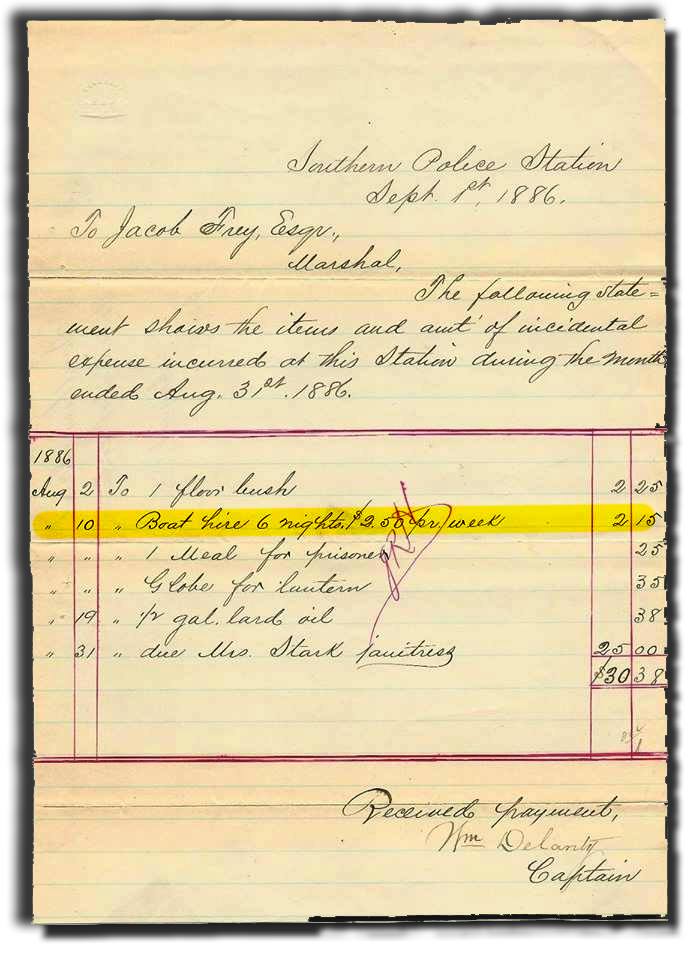
Information from an 1886 Sun Paper article told us of how the department used to rent rowboats to cover their posts in the harbor. In fact, rumor had it that we used four boats, one in the Southern District, one in the Central District, and two for the Eastern District. The theory being the Marine Unit didn't start until much later [1891], and that the District's each took care of harbor patrols from 1860 until that1891 date. This receipt is for six days of a Southern District Boat rental written out to Marshal Jacob Frey. This shows us that it was the District, not a Marine unit that handled the waters bordering the Southern District, also by giving us a price of $2.50 a week and a total of $2.15 for six days, show it was just one boat at approx. .36 cents a day. If they had more than one boat the price would have been as much as four times higher. This is a great document to help us confirm these dates in history, it also shows this research is much like working a criminal case, which is partially why I enjoy looking up our history so much. A boat livery is a boathouse or dock on a lake or other body of water, where boats are let out for HIRE (rental), usually on an hourly, daily or weekly basis ...
![]()
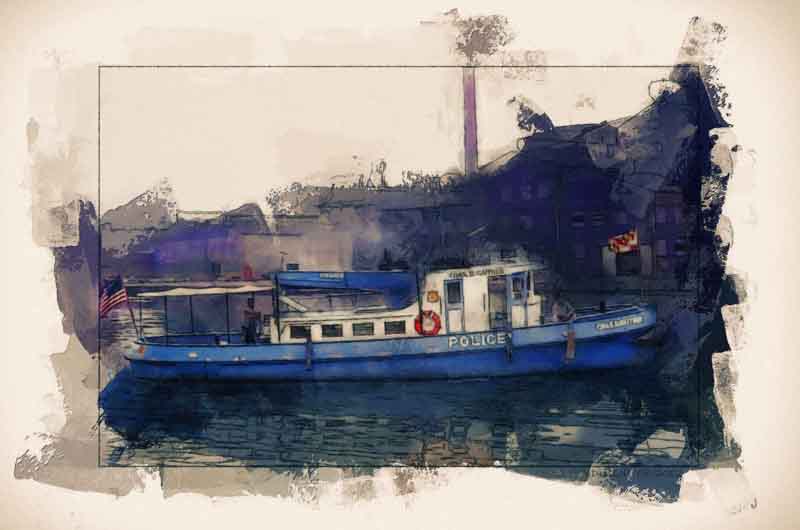
Baltimore's H2O Police
14 Sept 1940 - The CHARLES D. GAITHER was placed in commission with the Baltimore City Police Department's Marine Unit. Named after the first police commissioner of the modern era; prior to Commissioner Gaither, we had a panel of three commissioners. Commissioner Charles D. Gaither was a Brigadier General having served seventeen years in the capacity of Police Commissioner from 1920 to 1937, longer than any Commissioner has ever sat. CHARLES D. GAITHER (The boat) here on out to be referred to as "The GAITHER" came back into public service when her ownership was transferred to the Baltimore & Chesapeake Steamboat Company in July of 2011.
In fulfilling her former owner's wish to see the GAITHER continue to be a vital part of teaching the City's municipal history of Baltimore’s Harbor, the nonprofit group wishes to highlight the vessel's history, (having served both the Police department, and the Fire Department) it is important to highlight all of the departments she has served.
The GAITHER no longer patrolling the harbor shorelines, or responding to alarms with her pilot-house mounted fire monitor. Today, and for as long as there are lessons to be learned, The GAITHER will seek to be the method used to spark ideas, and use her decks to serve new generations as they answer the call to become protectors for the Port of Baltimore, and the citizens of Chesapeake Bay Country. ( Info obtained from W Frank Mathers - Baltimore & Chesapeake Steamboat Company )
Learn more about the Gaither (both the Commissioner and the boat) on this site. Enjoy and always if you have info or pics, please send them our way.
The Gaither was eventually sold to the Chesapeake Shipbuilding Co. in Salisbury, MD. The company lists it as still active. Spedden built all or part of 292 boats over the years, most of them tug boats and tenders. The company was sold in 1950.
![]()
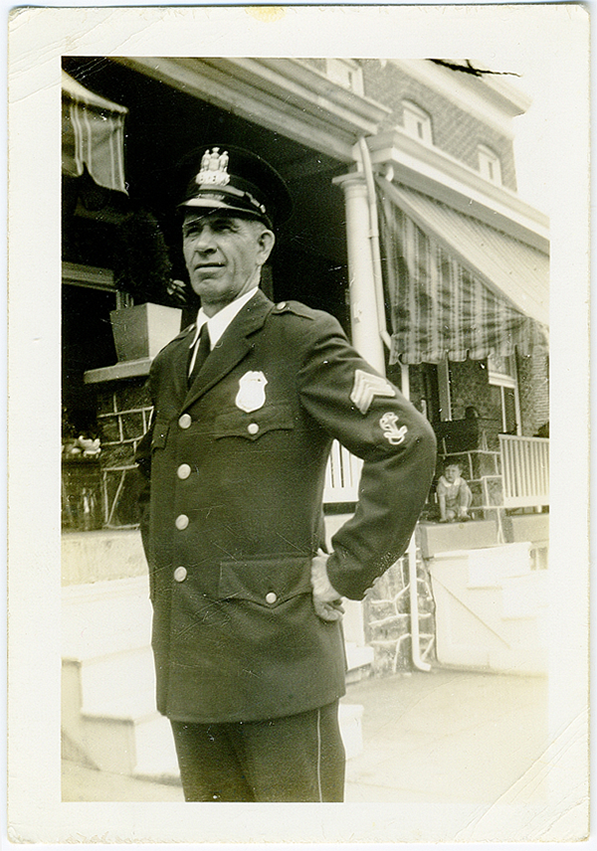
James Joseph Roach
1944![]()
Ran Into the Torpedo-Boat RODGERS
Patrol-Boat LANNAN Strikes Torpedo-boat RODGERS During Dark of Night.
Was it a hit and run? You be the judge.
During the overnight shift of Monday, October the 18th, 1897, the watchman at the Columbian Iron Works and Dry-dock Company, a shipyard facility in behind Fort McHenry on North Locust point, observed the Baltimore City police-boat LANNAN come into contact with the steel-hulled torpedo-boat RODGERS as the former was attempting to back out of the shipyard toward the channel. The RODGERS had not yet been accepted into commission by the United States Navy.
As a result of the collision, five of RODGER'S side plates were bent in and one frame broken in the ward-room. The plates may have had to be removed and all of the woodwork torn out so as to have the repairs made.
Although the watchman, who may have been under the impression that the LANNAN was in pursuit of harbor thieves, attempted to hail the LANNAN, there was no reply and the watchman paid no further attention to it.
It was discovered after dawn on the 19th. that the RODGERS had, in fact, been run into by a vessel on the bluff of her port bow while lying inside of the wharf at the yard.
LANNAN was ordered into the yard later in the day where it was discovered that her own bow fitted the depression made of the RODGER'S side. It was also noted that the bow of the LANNAN had been slightly damaged.
Late on Tuesday, it was stated by John P. Dorsey, of the LANNAN'S night shift that the accident had occurred while the patrol-boat was in his charge, during the absence of the vessel's captain, Lieutenant Napier. Crewman Dorsey stated that:
"We were running close to the Columbian Iron Works. George Lehman was at the wheel and Charles Perry was in the engine room. I was standing at the door of the engine room, when Lehman called out that there was a boat ahead. I ran forward and saw a little rowboat with two fishermen in it. I told Lehman to turn the wheel and avoid running down the boat, but after we had narrowly escaped a collision with the fishermen I perceived that we were running into the Columbian Iron Works. Immediately afterwards I saw that we were very close to the torpedo-boat. I ordered Lehman to ring the bell for Perry to back water, but before this could have its effect we struck the RODGERS near the starboard bow. The force of the collision was such that our boat rebounded and was about to come at the RODGERS again when Lehman managed to sheer off. I did not report the accident because I was not aware that there had been any damage done to the torpedo-boat."
 1891 - The Lannan (Launched 10 Aug 1891)
1891 - The Lannan (Launched 10 Aug 1891)
1911 - Robert D. Carter
1928 - The George G. Henry (Launched 1 Nov 1928)
1940 - The Charles the Gaither
1946 - The Beverly Ober
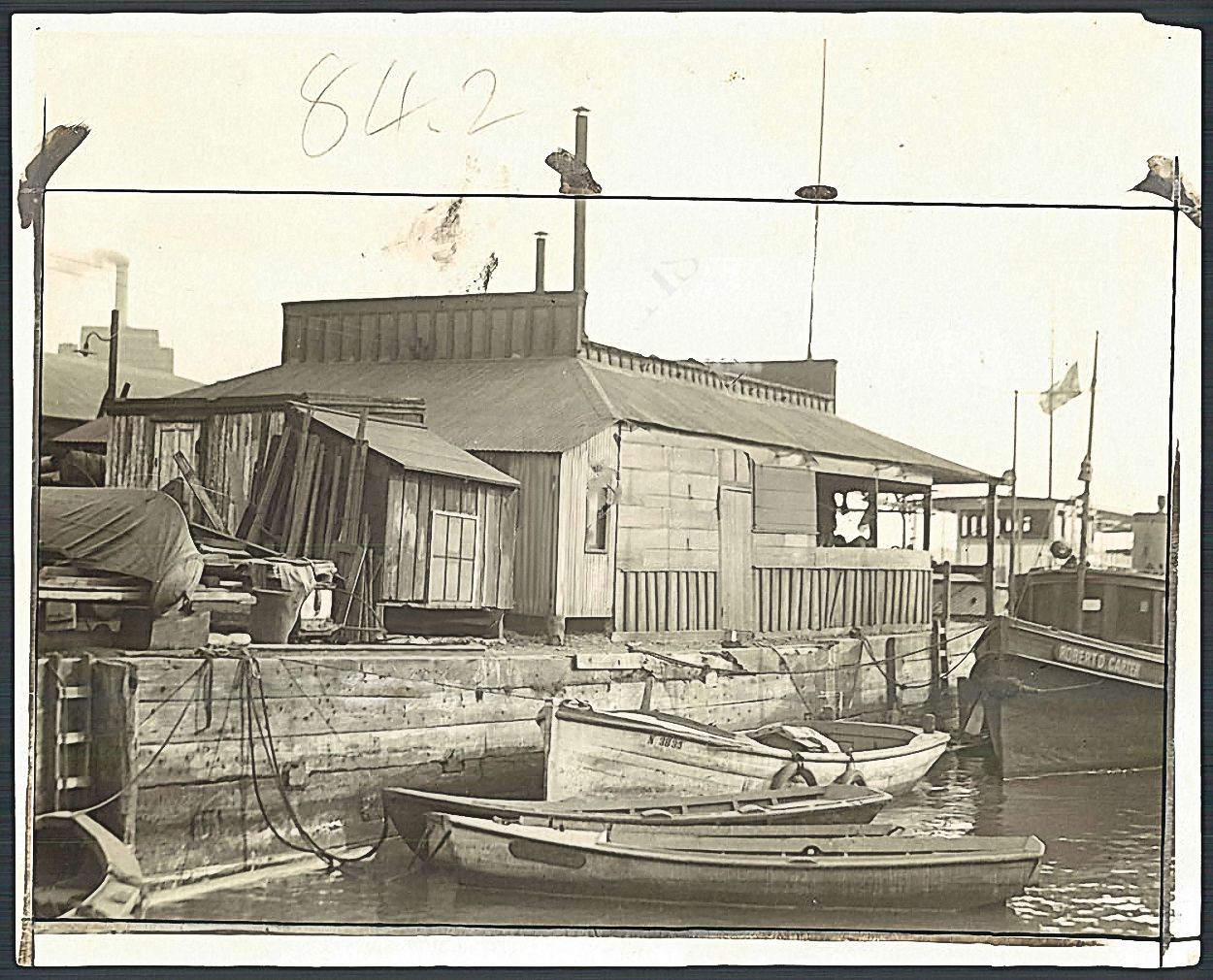
The Harbor Thieves
The Sun (1837-1987); Jul 27, 1886; pg. 4
The Harbor Thieves
The police have not yet arrested the thieves who robbed several vessels early Sunday morning in the harbor. The thieves are supposed to be the same who robbed one vessel in Washington last Friday night. Robberies have been reported all along the coast. And the police have good cause for believing that a band of professional thieves are doing the work as a great deal of adroitness and system have been shown. In speaking of the need of better facilities for capturing the thieves, police Marshall Frey said he had made a written recommendation on the subject to the board of police commissioners, as follows; “There exist a necessity for a harbor police boat, as many depredations and other offenses are committed on vessels and along the shore by persons in small boats, the policeman on land in many instances being unable to see or hear them, and in many cases when seen or heard the thieves are enabled to escape for the want of proper facilities to pursue and arrest them. About 18 years ago we had yawl boat doing duty about the harbor and it did good service, but the demands for policemen on land compelled us to abandon even that crude system of harbor protection. ”The police board recognized the importance of this recommendation and incorporated a provision in an act to better define the special fund in the hands of the board so as to provide for a harbor patrol boat, but the provision was stricken out when the act was passed by the last legislature. The special fund is raised by fines imposed by the police magistrates and is used in building station houses, for patrol wagons and pensions. The Marshal says that New York, Philadelphia, Boston and other cities have harbor police boats, which is a great help in protecting vessels property, he says that the Baltimore needs a steam yacht, with about four rowboats. The yacht could move up and down the harbor all night long, and the rowboats could patrol the docs under the direction of the yacht, which should have its regular police captain. He thinks it would require about 15 or 16 additional policemen to do the work thoroughly. The Marshal said also that the people of the city have no idea how many thefts are committed in the harbor. The only vessel Robberies usually reported in the newspapers are those of jewelry, clothes, and money, but by far the largest loss is in production, which is stolen so successfully that the captain of the vessels and the owners of the produce are not aware of the robbery until the produce is taken out and a shortage discovered. It was too put a stop to these robberies, as well as to catch the professional thieves, that the Marshal recommended the establishment of the harbor police boat. Mr. George Colton president of the board says that he does not think the board could establish the harbor system without special legislation. The board, as well as the Marshal and deputy Marshal, recognize the necessity for a patrol boat.
GUARDING THE HARBOR
Reported by the Baltimore Sun
The Sun (1837-1987); Jul 31, 1886; - pg. 6
Guarding the Harbor
Policemen in rowboats on the lookout proceeds – the patrol wagons.
Marshall Fray, acting under instruction from the police board, has organized a special system of police protection for the harbor of Baltimore. He has four flat-bottomed boats and 12 policemen now engaged in the work. Three policemen are assigned to each boat each boat will carry two pairs of oars so that in case of a chase two men can pull. Each boat will also be provided with a dark lantern. The policeman selected to do this duty have been chosen from those who are best acquainted with the harbor and its immediate surroundings. Of the four boats, two have been assigned to the Eastern district, one to the Central and one to the Southern District. The boats will start out at dark and remain on duty until daylight.
Pres. Colton, of the police board, says that this experiment was started as the best thing the board could do under the circumstances. In the absence of necessary legislation upon the subject. The board could not place a regular steam patrol boat in service. At the last session of the legislature, he had asked for a police boat, but the legislature would not consent. The present experiment will cost but little, as the boats are hired by the night at a small cost. There is a reason to believe that it will prove successful.
Marshall Frey is speaking of police protection to the harbor, said a steam launch was undoubtedly the best means of guarding the harbor. He could not definitely state what kind of boat would actually be the best, but his impression was that a boat should be built with all the conveniences necessary for the service. He thought that about 25 men would be a fair compliment. The present experiment would he said be a great move in the direction of harbor protection, and that nothing better could be done until the next meeting of the legislature when the request for a police boat will be repeated.
The arrangements for the introduction of patrol wagon system are nearly completed: all of the polls have been placed in positions and the wires run. The boxes will probably be placed in position next week the new wagon for the southern district is finished. It was built by Mr. John F. Bunter, of Baltimore. It is somewhat similar to the wagon used in the Central District but has several improvements. The body of the wagon is 7 feet long. To the left is a small apartment for the stretcher, was can be placed in without the slightest difficulty. A similar apartment on the right can be used for placing heavy weapons in case of an emergency. The entrance is by steps in the rear. The steps are all finished and brass. The body of the wagon is painted black. The wheels are Carmine with yellow bordering. The wagon will be drawn by one horse. The work of interest to seeing the system in the Eastern district is also making rapid progress.
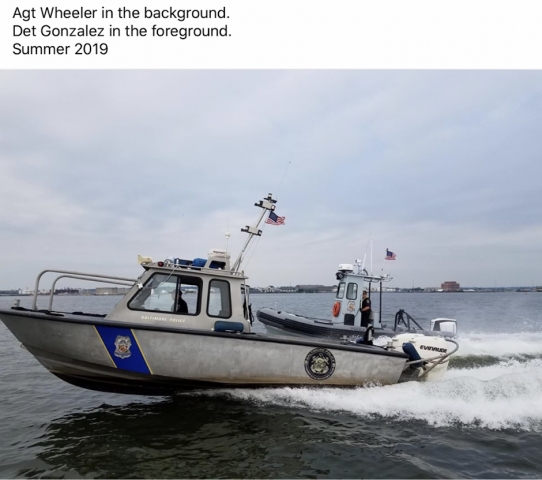
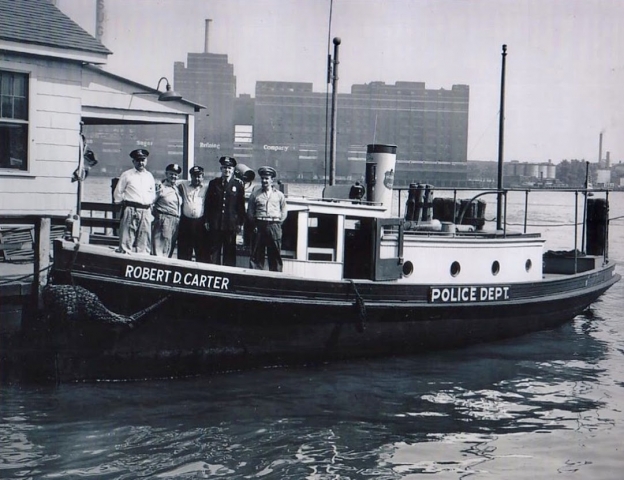 Courtesy Ret LT Bob Wilson
Courtesy Ret LT Bob Wilson Courtesy Ret LT Bob Wilson
Courtesy Ret LT Bob Wilson

Aug 7, 1886
THE HARBOR PATROL
Reported for the Baltimore Sun The Sun (1837-1987); Aug 7, 1886; -pg. 6
The Harbor Patrol
A trip in one of the police boats – sites revealed by the dark lantern.
“Where’s Your Light?” The words were followed by a flash of the dark lantern which made a halo of bright in circles the head of a colored man who was scuttling a boat at night toward a fleet of bay vessels lying ahead to the wind of Henderson’s Wharf.
“Boss, I just took somebody the shore,” and the orbits of the surprised fellow in large as he winked and blanked in terror of the unseen questioner. The man shaded his eyes tried to pierce the glare of the lantern but every moment was followed by the blinding light before him.
A quick flash of the light was cut off, revealing to the scared darkly three policemen in one of the harbor patrol boats of the Eastern District. In the Stearns, sheets set a Sun reporter, who was temporarily coxswain of the swift little cutter. After instructing the Charon of the reason he was challenged he was permitted to go and was a happy man.
A cruise with a harbor patrol is an interesting feature in that branch of police work recently inaugurated by Marshall Fray for the protection of property on wharves and on shipboard . Therefore boats on duty nightly, each containing three officers, who have been selected on account of previous acquaintances with the harbor and their knowledge of handling boats. The work is divided into four boats. Beginning at the southern extremity of Light Street Wharf the Central crew patrols along the Steamboat peers: thence on the north side of the basin to the drawbridge. Commencing there, number one crew, of the Eastern District patrols to Henderson’s Wharf, where number two crew picks up the work and extends it to the Lazaretto light. Capt. Delanty’s crew and the southern district have the south side of the harbor, including the shipyards, coal wharves and steamship piers as far as Fort McHenry.
Capt. Auid, with foresight born of experience with ships and boats, selected two handsome cutters which formally were one Mr. T. Harrison Garrett’s yacht Gleam. They are particularly adapted for the work, being light and easily driven through the water. Two officers pull while third attends the filler, bundles the light or give directions. A system of order and regularity is in force. Each man is assigned to some detail of the boat or his charge of some of the gear so that no confusion can occur.
On the night in question there was a strong southerly breeze, which made the harbor a little lumpy, causing the motion of the patrol boat that guards the Canton hallow to leap and jump over the waves as it delighted with the change from the smooth water that prevailed under the ice of wharves and ships further up.
Strong and sturdy polls made the cut or skim over the water like a recent shell. The unexpected incidents during the trip were in some cases very ludicrous. Suddenly pounding the stern of the vessel, a wharf came in for inspection. The dark lantern soon showed that the officer in the bow was on the alert, and on lighting up the wharf with the lantern two lovers were on graciously surprised. The head that rested on Romeo’s shoulder became erect abruptly as if it never knew any other position, and Romeo himself appeared very much confused. All was darkness again in the boat and on the wharf as the light of the lantern were set off, and maybe the old, old story was whispered once more under the inspection of the waves that gurgled beneath the pier.
Past lonely wharves and warehouses, where everything was quiet: under Stern of great ships loading for C; nearly grazing the head while passing under the bow of some small craft: then up and obscured dock, peering under peers: then darting after a boat with a lone occupant to learn his business: past steamers banks and ships, factories and furnaces, and then under the glare of the two red lights of the Lazaretto, which marks the bounds of the police patrol, the little boat silently, swiftly collided.
In the distance, the lights of the city twinkled and the street showed their outlines by the regularity of the gas lamps, which appeared like a Torchlight Procession. The only noise on the water was the swishing of the waves against the seawall, or the pool – pull off some belated tug returning to point. Occasionally the crew rested on their oars and drifted with the current, or stopped to scan an object that looks like a boat.
The duties of the patrol are multifarious. Vessels are boarded, and those onboard instructed on the necessity of keeping doors locked and look out on property lying about decks. Every rowboat or sailboat is now known by the patrol. They know to whom it belongs and where it ties up. His absence suggests inquiry, and its whereabouts are determined. The route of the patrol is governed by circumstance, but with and every hour the whole beat is twice covered. Preliminarily to the general cruising, vessels which arrived during the day are located and made aware of my duty of keeping a lookout.
An illustration of the carelessness of master of the vessel was given the other night. A light was seen through the open door of a schooner cabin and rather an unreasonable hour. The patrol went alongside and halted the vessel. No one responded for several minutes, and then not until the oars had been used in a knock against the cabin a man came quickly up the companionway rubbing the sleep from his eyes. He was told of the probability of seeds being invited to call upon him, and as a precaution, he closed his cabin. “If all Mariners sleep like that fellow and his crew,” said the officer, “chloroform need not be used.”
Jul 3, 1891
POLICE BOAT LANNAN
The Sun (1837-1987); Jul 3, 1891, pg. 6
Police Boat Lannan
A well – Deserved Complement to Deputy Marshal Lannan
The Vessel Successfully Launched
The Police Patrol Boat – built by James Clark and company was launched at 4:55 PM yesterday (2 July 1891) from the yard of the contractors on the south side of the harbor. Miss Georgia Shriver daughter of Mr. Edison M. Shriver, president of the board of police commissioners, christened the boat as it moved from the waves, by breaking a bottle of wine over the bowels and repeating the words “I name you Lannan,” the name is an honor of Deputy Marshal John Lannan, who has taken great interest in the boat, and superintended its construction. Among those who saw the launch were Police Commissioners Shriver, Gill, and Robson, ex-Marshal John T. Gray, Dr. P. Brysonwood and Dr. J. E. Heard, physicians to the police department; J. A. Kinsey, secretary to the police commissioners; Capt. of Detectives Freeburger, Detectives Gaunt Barringer and Hogan, Fire Commissioner George May, Capt. Farnan, of the Central District; Capt. Claiborne of the Southern District; Turnkey Arthur Nappier and Patrolman Lloyd, and League of the Central District. Firemen age. Berman, of number 4 Engine Company, secured the neck of the wine bottle, which he will present to Marshal Lannan after having it suitably framed.
The Lannan is a boat made of steel, 60 feet long, 13 feet beam and 5 feet depth of cold. The engines are of the compound type. 6 ½ inches and 13 inches in diameter of cylinders, with a common piston – stroke of 9 inches. Award boiler is to be used. There will be ample accommodations on board for the crew of the boat.
The police patrol boat will be finished and put in commission in about three weeks (23 July 1891). The commissioners have not completed their plans for the work of the boat and it is not yet decided whether the boat will be run both day and night, or have but one crew and be used to patrol the harbor at night only. The number of men to form the crew was not yet been determined upon, but there will be probably four, or five on board. The rank of the officers who will command the boat has not been decided either. The boat will have a prescribed course to go over, and the crew will keep a close watch for harbor thieves and fires, and also assist sure officers when occasions require. Call boxes will be placed along the waterfront at convenient places. Through which the officer in charge can communicate with the different police stations and receives special instructions for emergencies and called the patrol wagons when needed.
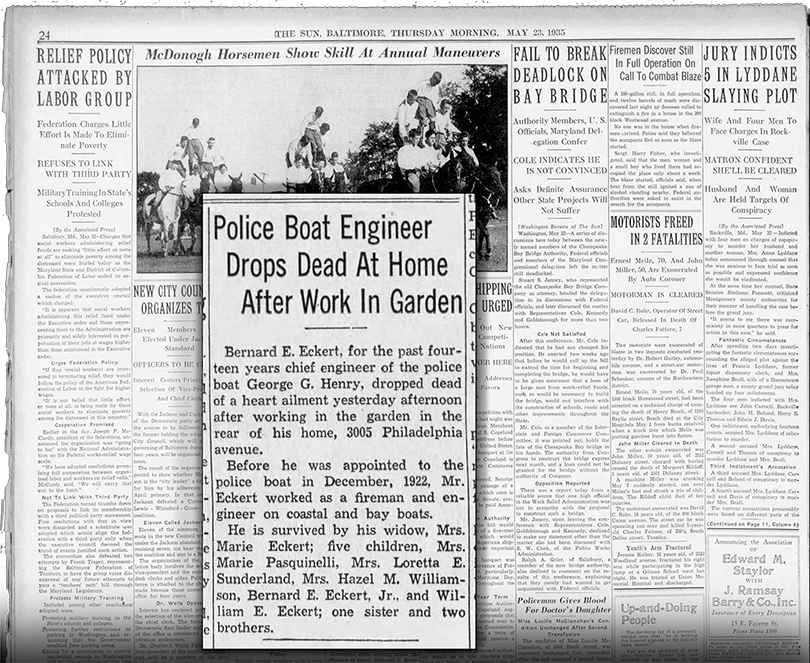
Is it just me, or did the newspapers seem heartless? This was not just our brother, but he was a Husband, a father, and a son. Yet the Sun Paper still thinks it is OK to write, Police Boat Engineer Drops Dead 23 May 1934 - Long before I was born, and I never knew him or of him, but to read a title like this does bring a little sadness to those that read it, just the careless description on a human being that had to have been socially acceptable. Anyway, I hope at this time in our lives we would give more respect to those that have passed, and give him a minute of our time to read the article and pray that he Rest In Peace.
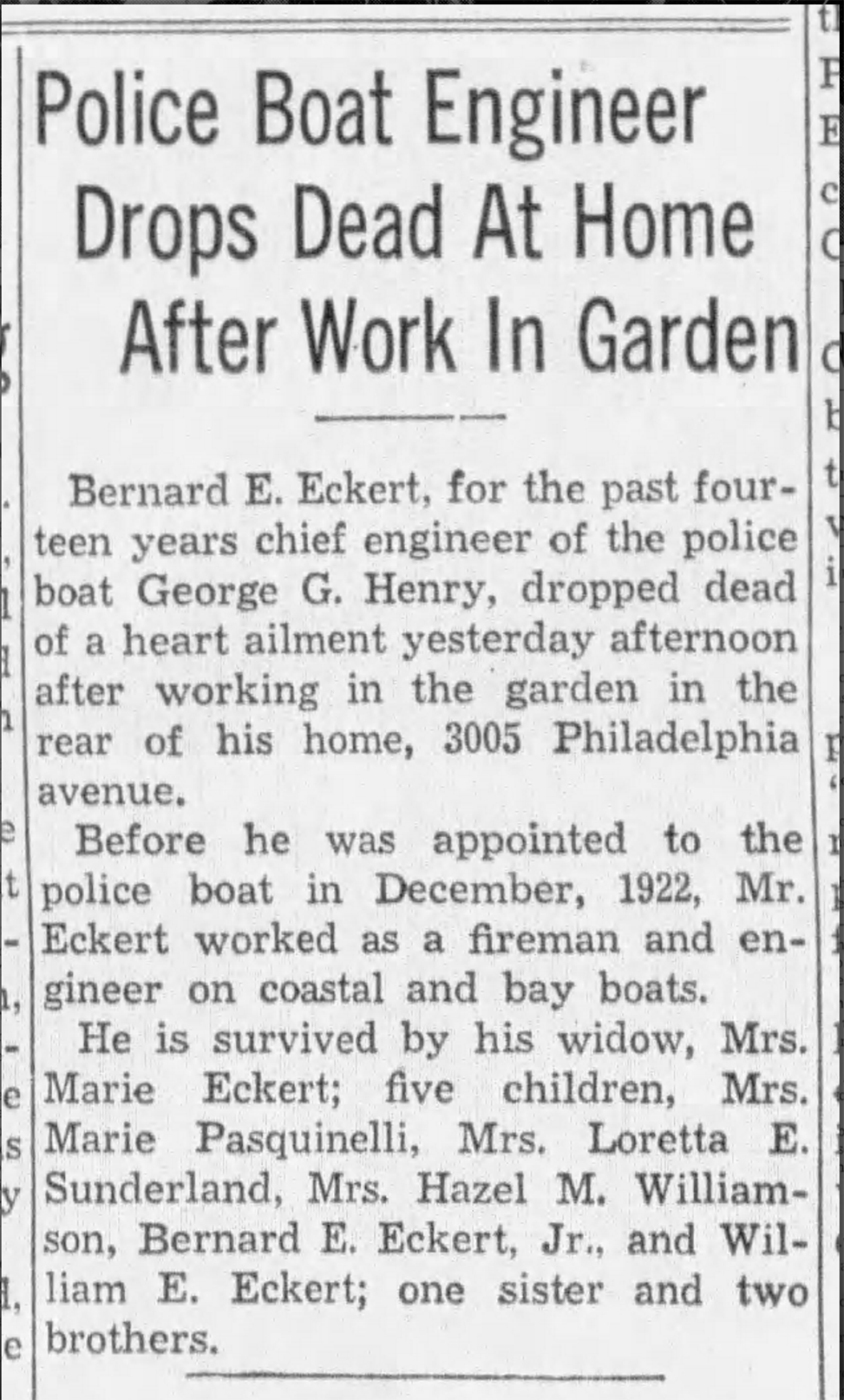
Skin Diving Team
2 March 1960
2 March 1960
May 24, 1908
History of the Steamboat on the Chesapeake
The Sun (1837-1987); May 24, 1908; pg. 17
HISTORY OF THE STEAMBOAT ON THE CHESAPEAKE
XX – – – LUKE LEAGUE, TUGBOAT PIONEER
Once upon a time – as the fairytales begin – as long ago as 1849, the Baltimore man, Luke league by name, set on the wharf at light Street and watched the sailboats, moving a window from the West, laboriously creeping into the harbor.
It was a worrisome method they employed to make the harbor, and it was called kedging. Sailors in the ships you’ll carry a small catch anchor with the line attached. Would row ahead several hundred feet and drop the anchor, and then the ship's crew by means of the captain would have the ship up to the point where the anchor was fastened. The operation had to be repeated over and over until the vessel was docked.
A MAN OF ENTERPRISE
Luke league was born in during the exciting year 1812, on Albemarle Street, in the neighborhood of old Carol mansion, at the corner of Front and Lombard streets. He was of an initiative temperament. He is said to have introduced the charcoal business into the city and to have operated the first mill in Baltimore to Saul and split wood.
With an intimate friend named Cooper, Luke league continued to watch the hedging process as vessels moved up and down the harbor, and finally, in the year 1849, he conceived the idea of introducing towboats, propelled by steam, into the Baltimore shipping circle.
In the same year, he purchased the tow boat Hector at Wilmington, Delaware, and brought her around by sea to Baltimore and thus introduced to the tow boat or Tugboat business in the port of Baltimore. The Hector was 35 hp. Her length was 60 feet, breadth, 16 feet, depth 6’6” and tonnage 53. In 1850 Capt. League purchased from Delaware the Haas well, also a small vessel. Both boats were commanded by him personally and the distance they usually towed outgoing sail ships or steamers was to Swann’s point, near the entrance to the bay. Annapolis was regarded as an unusually long distance to tell, and there was no vision of the future that 59 years later the commercial marine industry thus introduced would be carried on by some 80 tugboats, those routes extend from Baltimore Harbor to the open sea. Some of the tugboats now in commission have 1000 hp and the fleet represents about $2 million capital invested.
BUILT A TUG BOAT FLEET
Inspired by the success of his enterprise Capt. League built a number of tugboats later on, among them was the lioness, tigress, Ella named for his daughter Ella league and which had a figurehead of the lady, and the Mary, named for his daughter in law, the wife of his son; Capt. Albert H league.
In the year 1865 Capt. League, in conjunction with his Messrs. Deford, Hooper and Huggins, built the steamer, Harriet Deford, to run on the Patuxent River as far as Benedict, and also to landings upon the Bay shore. The Civil War began in progress, the boats of most of the day lines were in use as government transports, and for three months the Harriet Deford ran successfully over her chosen route.
On April 1, 1865, the day before the evacuation of Richmond, the boat has boarded a band of 13 Confederate gorillas, headed by a soldier named Fitzhugh, a nephew of Gen. Robert E Lee the boat was taken by her captors to dividing Creek, where she was foundered and burned. The engine and boiler were afterward recovered and placed in a steamer, James A. Gary.
A RAPID RESCUE
A pretty little story is told of Capt. League, that he was once visiting a shipyard and noticed a little girl busily engaged picking up chips, which she carried in an apron made of her tiny skirts. By a misstep, the child suddenly fell backward into the water and Capt. League plunged so quickly after and rescue her that the child had no time to realize her danger, and her first word on reaching Tara firms was, “where are my chips?”
Capt. Albert H. League, born 1838, and son of the Pioneer Tugboat master, was acting in the capacity of Capt. at the age of 17 and continued to command tow and steamboats until his death, 1882, by drowning, off the tug Britannia.
CHIP OF THE OLD BLOCK
Lieut. Albert L. League, born in 1863, has followed in the footsteps of his father and grandfather. He commanded a boat at 20 years of age and was master of Dougherty’s tug Oriole until he resigned to become a member of the police force. When the police boat patrol of Baltimore Harbor was introduced he was assigned to duty upon the police boat Lannan, with which he is now associated with the rank of Lieut. Lieutenant League is said to know Baltimore Harbor so well that he can navigate his ship blindfolded. The life – saved a record of the League family is full of honor. Capt. Luke league is credited with having rescued in 19 lives; his son Capt. Albert H. League also saved a number of persons from drowning and Lieut. Albert L league has been officially commended by the board of police commissioners for having saved three persons from death by drowning.
 Click on the above pic to see the full size article
Click on the above pic to see the full size article
George Henry with John Santry
![]()
Feb 23, 1958
I Remember ...Baltimore's First Police Boat
The Sun (1837-1987); Feb 23, 1958; pg. M2
Baltimore’s First Police Boat
The boat in the foreground here is the Lannan, Baltimore's first police boat. It went into service in 1891. Before that, the harbor was patrolled by rowboat. This photo was made at Light and Pratt in 1905.
When I see the sleek police boats, Charles D. Gaither and Beverly Ober
my thoughts go back to the .1920's when the steamer Lannan and the gasoline has driven Robert D. Carter was the pride of our waterborne police.
My association with the old vessels was purely from the standpoint of pleasure.
As a boy during the summer months and winter weekends, I had the opportunity to make the circuit of the harbor on the vessels' as they carried out their duties. My buddy's father, Ben Eckert, was chief engineer on the Lannan and through this connection, we were given the privilege of making the harbor trips.
Of the two boats, I was more impressed by the Lannan. She was the first or the police boats and was built something like a steam, tug. Her ranking stack, arched windows and cabin doors, polished brass and ·colorful painting gave her the air of an old-fashioned yacht. There was a certain amount or adventure involved in cruising around on the Lannan. Besides patrolling the harbor the boat's mission was to investigate suspicious boats and persons, guard, against sabotage, assist in putting out fires, make rescues, recover stolen property and remove floating bodies.
The boat's headquarters was at the foot to Philpot Street and Crom that point she would depart on schedule to sail down the harbor to the vicinity of Fort Carroll, then over to Quarantine, up Curtis· Bay, into the middle and northwest branches of the Patapsco, and to her slip again. Standing vividly in mind was the Lannan's trip across Canton Hollow.
That was the anchorage for the scores of bay sailing craft that were waiting for a berth or were ready to sail down the Chesapeake again.
Further down the Patapsco could be seen at anchor the big four-mastered schooners in from the West Indies or some coastwise port. When the Lannan reached the upper harbor and cruised parallel to Light Street we would pass close to the .sterns of the many steamboats which connected this port with the tidewater sections of Maryland and Virginia.
Outstanding among the crews of the boats was Capt. Edward J. Carey, a veteran of the force and in charge of the marine division during my time. He was a stout, jolly fellow, a native of Ocean City, and he used to give us youngsters (his boy would also make the trips) some of the backgrounds of the harbor police.
I recall his telling us that the harbor was first patrolled by officers in a rowboat. I later learned that it was in 1860 that the Maryland Legislature gave the newly organized Baltimore Police Department jurisdiction over the harbor.
That is when the harbor police became organized, and for 31 years the waters were patrolled by rowboat-until 1891 when the Lannan was built.
A few weeks ago I had the opportunity to look through her first log book. Some of the entries gave a good picture or what she encountered in enforcing the law. Some of the tasks she was called upon to do were to quell shipboard fights and mutinies, extinguish waterfront fires, check for smugglers and stowaways, remove injured seamen from ships, and tow off stranded vessels.
The Lannan didn’t always confine her activities to the restricted waters of the harbor. Quite often she made long trips down the bay in search of criminals who were crew members on local ships. The Lannan was named after Baltimore's Deputy Marshal John Lannan. In 1917 she was given relief by the addition of another police boat, the Robert D. Carter, named after the marshal of police. In 1928 the Lannan was retired after accumulating an estimated mileage equal to eight times the distance around the earth. She was sold to private parties, who converted her from steam to diesel and used her as a towboat on the James River. Later she was taken to Atlantic City to tow garbage scows to sea.
She came back to the Chesapeake again about 1935 under the ownership of Capt. George Curlett, or this city. He planned to use her as a towboat in the lower bay. Sold again, she was used in construction work around the harbor, and in 1948 was finally broken up for her metal at the A. Smith'& Sons shipyard on Curtis Creek. To replace the Lannan the ' George G. Henry was built in 1928 at Annapolis. Her career was comparatively brief; she was replaced by the Charles D. Gaither in 1940, the latter vessel is still active, with the newest addition of the Beverly Ober, built-in 1946 to replace the Carter.
![]()
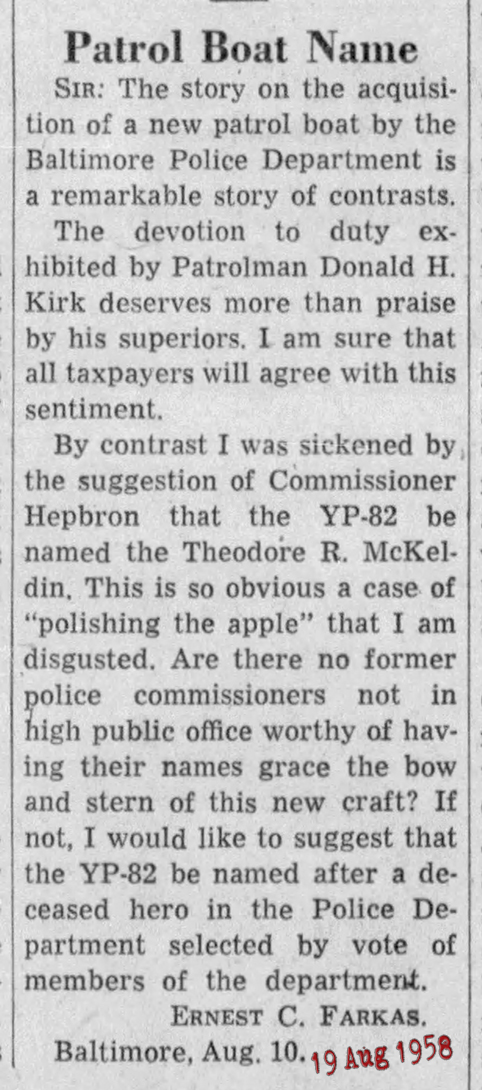
![]()
Nov 6, 1938
Harbor Police Perform Tasks Without Fanfare
But Reports Show Value Of Their Patrols
The Sun (1837-1987); Nov 6, 1938; pg. CS6
Rowboats Carried Patrols on Their Rounds for 31 Years until Legislature Provided Funds for Launch in 1891
by Herbert Weaver
Few people have heard of it, simply because they haven’t come in touch with it. But it does exist, has for years, as ably and efficiently performs its duties day in and day out, it tries to rescue the drowning, keep ship strikes in order, pick bodies out of the water, chased nudist swimmers off the empty piers and docks, lockup disorderly stevedore’s – in general, keep Baltimore’s Harbor peaceful.
The “it” is the Baltimore Harbor Police, a force of 15 men, who extend the postulated long arm of the law over the turgid waters of the Patapsco.
In the year 1860, the Maryland legislature passed an act giving the newly organize Baltimore Police Department police jurisdiction over all the area comprised of the incorporated towns and limits. By specifically designating all the area the legislator called attention to the fact that both the land and water were included within the boundaries. Indirectly it was this act of 1860 that created the harbor police. If the police themselves were to be a model of exemplary conduct for the citizenry to follow, they must first comply with the law, and the law, in this case, meant patrol duty over land and water. The harbor patrol was in fact compelled into existence.
A Stiff Problem
There was a problem, a very stiff problem at first. How was the police force going to patrol the orderly, choppy waters that raced about in the harbor? Is there feet were reputedly flat and big, of course: or were supposed to be.
But even feet have their limits, and policeman’s feet at the time weren't exactly barged. They hadn’t the funds to buy a patrol boat. What then? Well someone conceived the idea of placing rowboats in advantageous positions at the points where the various districts touched the harbor’s waters. It would then be a simple matter of jumping in the boats at the required time and pushing out from land and rowing over the regulated beats. It was all somewhat surprising, efficient and a novelty at that.
The idea caught on and stayed put. For 31 years, from 1860 until 1891, this method was in force. For that length the time the harbor was policed in rowboats manned by Bluecoats, who at first was anything but at home abroad. Then in 1891, the long-awaited funds were appropriated by the Legislature and a steam – run cutter was purchased. The quixotic picture of a mustached and belabored crew of policeman, sweating over their oars, in pursuit of a nudist swimmer, became a thing of the past.
Lannan Purchased
The money bought the Lannan for $8370 compared today with the George G Henry, the craft named after Deputy Marshal John Lannan would seem obsolete and perhaps a little force. But in the early 1890s the trim little boat, as she steamed up the harbor, her breast trimmings pending sunlight in the spectator's eyes, was the pride of the entire police department. There wasn’t a man on the force who didn’t speak of her with affection. She was their mascot.
The Lannan was to see many years of service before she was to be laid away and dry dock heaven, dismantled for scrap metal. From 1891 until replaced in 1928 the boat was to be a familiar sight in the harbor to dock hands, stevedore and landlubber alike. Covering her beat day in and day out she ended by pulling up the amazing mileage equal to the distance of nine times around the earth. The officers and crew were recruited from the regular police force. Engineers and firemen, licensed by the government, were brought in from the outside and paid respectively $18 and $12 a week. Later the boats were manned entirely by men who were on the force.
New Boat Added
As the years rolled on another patrol boat was added to assist the tiring Lannan in her 9 mile joint around the harbor. This was the Robert D Carter, added in 1911, named after Marshall of police Robert D Carter. It was a small but serviceable boat, 45 feet long and gasoline propelled. Because of its size, the Carter was not taken out of rough weather unless the Lannan was in dry dock or out on duty. Today the Carter is still in service, helping out the George G Henry.
When in November 1928, the harbor police received the George G Henry in place of the Lannan, they came into possession of a boat that increased the efficiency of the force an estimated twofold. The Henry is a fast, poignant cutter. Covering the 9 mile beat in less than an hour and drawing but 4 feet of water.
Excellently Equipped
The Henry is excellently equipped. It has 150 hp motor, twin screw engines which will develop a speed of 16 miles an hour, two 600 gallon fire pumper thanks, a heating plant, an electric refrigerator, and a two-way communication set were central headquarters. The latter, a recent innovation, enables the Henry to receive orders direct from Central when out on duty. Up until his death in 1931, Capt. Edward J Carey had been in command of the Henry; then it was turned over to Capt. Harvey Von Harten, now head of the harbor police.
The headquarters of the force is located near the foot of Broadway, at the end of Philpott Street where it meets Wells. Surrounded on three sides by lumber yards and smoking chemical factories, the tumbledown shack of a dirty Fated Gray furnishes a perfect setting for a C story of blood and thunder. But there are no such stories and very little blood and thunder. Lying about the yard were miscellaneous knickknacks picked up in the line of duty. Worthless as they are they lend in an atmosphere of this see that blends well with the place.
A Seaman’s Hangout
Inside, under the corrugated metal roof that calls for repairs before and after each storm, is a variable Seaman’s hang out. Here 15 policeman make their headquarters, working in eight-hour Shifts of five men. It is their home. They cook their own meals, wash and iron their clothes, do mending at times, pursue their own hobbies. Is a bit of an isolated life itself, comparable to the independent insular existence of Robinson Crusoe. All the men like it, have spent the best part of their lives at it.
23 Years with Police
When one asked Capt. Von Harten how he likes his job and what he does, he will answer with a smile that he has been with the harbor police for 23 years and that he does very little except run the Henry over her inspection trips of the harbor every 2 ½ hours or so. He and these the uptown policeman who, he claims, have a monopoly on all the excitement. The captain himself is a big man, bulky, heavy, square of the shoulder, with the weatherbeaten face and arms and shoulders, watery blue eyes and terse of silvery gray hair that tosses in the breeze. He is at all times friendly, except when interrupted and his afternoon's rest.
As for the captain's repetitious protest that the force does nothing – nothing, that is, but the usual routine – it would seem in the light of the police commissioners report of 1936 to be that of a very humble man, indeed.
The report is this
Arrests - 3
Bodies Recovered from Bed of Harbor - 14
Bodies Found and Removed to Morgue - 49
Injured Persons Removed from Vessel - 1
Fires Responded to - 5
Vessels Assisted - 10
Value of Property Recovered - $12,379
This report does not include the protective value of the force; for day and night, the whole year through the millions of dollars worth of harbor property is entrusted into the hands of the harbor police.
Undoubtedly, these men who rough it down where the foot of Broadway plants its heel in the Patapsco perform a where the service; and unknowingly many of Baltimorean has received some benefit from their hands
THE HARBOR POLICE
History Baltimore Police Department
1774 – 1907
Pages 144-146
Nearly everyone who patronizes the summer excursion boats and the score of passenger boats that enter and leave Baltimore Harbor is familiar with the sight of a trim looking little dark-hulled steamer that makes her way in and out of the tangle of shipping, skirting around wharves, running into tortuous docks, darting around the ships and steamships that lie at anchor at the wharves or in the regular anchorages. Sometimes at night, the passengers on incoming and outgoing steamers catch a glimpse of a dark hull close aboard them and then a glare from a searchlight is sent across their decks and searches the wharves that line both sides of the riverfront.
The little steamer is the harbor police cruiser "Lannan," named in honor of former Deputy Marshal John Lannan, deceased, who had charge of her construction. The Lannan was built in 1891 by James Clark & Co., from plans kindly loaned the Department by the United States Government. The harbor patrol boat was completed on August 10, 1891, and after a very successful trial trip was accepted and immediately put into commission. The steamer is sixty feet long overall and has thirteen feet beam. She draws about six feet of water and has seventy-five indicated horsepower.
Prior to the launching of the Lannan the harbor was patrolled by policemen in rowboats, but, as it can be very readily understood, this plan proved utterly inadequate to the police needs of nearly ten miles of waterfront. Since the time she was launched the Lannan has been continuously in service, save when she was in the ways for necessary repairs. In touring the harbor the Lannan averages nearly fifty miles per day, and as she has been almost steadily on the move since the day she was launched, she has, on a conservative estimate, traveled about 127,750 miles, a distance nearly six times the circumference of the globe. Prior to the launching of the Lannan, the vessels in the harbor and the warehouses along and around the wharves were nightly attacked by thieves who operated from the river. Frequently the captains of small vessels would go ashore to return and find that their craft had been stripped of everything movable, including cordage and sails. The commissioning of the police cruiser practically put an end to this extensive thievery, and the fact that she was equipped with a powerful searchlight and could train it over and under piers and on the decks of suspicious craft acted as a check to river pirates and criminals who lurked and operated along the waterfront. Shortly after she was built the Lannan was equipped with a fire-fighting plant, and the latter has been used to great effect in fighting fires in the warehouses and along the wharves where the steamer has her regular patrol.
The Lannan is also used for the recovery of the bodies of persons who are drowned in the harbor, and frequently she is called upon to go to distant points in the Chesapeake on the same mission. Her crew is trained in the expert use of the grappling irons and hooks with which the bodies of drowned men and women are fished from the river bed, and the deck of the little steamer has carried many a pitiful canvas covered burden, the earthly remains of some unfortunate who accidentally fell into the water or purposely sought death and oblivion in the murky waters of the harbor.
In the summer of 1906, the Board of Police Commissioners purchased a gasoline launch to act as an auxiliary to the Lannan. This boat was rebuilt and remodeled recently and was launched on May 4, 1907, when she was christened the Farnan, in honor of Marshal Thomas F. Farnan, who on April 30, 1907, completed forty years' continuous service as a member of the Baltimore Police Department. During the warm months, the Farnan will patrol the harbor instead of the Lannan, which will be kept at the Harbor Police Headquarters, Philpot, and Thames streets. Thus the Department will have two thoroughly able boats at its command should an emergency occur where the services of both the Lannan and the Farnan might be called upon. The members of the Harbor Police Force, who are commanded by Lieutenants Albert L. League and Edward J. Carey, are Patrolmen John B. Dorsey, Milton Harrington, and John J. Ryan. Thomas E. Perry is chief engineer and Charles H. Aborn, assistant engineer. Richard Murphy is the fireman and Richard Stanton is the assistant fireman.
In the last report of the harbor police service made to the Maryland General Assembly of 1905 it was shown that during the year 1904 property valued at $13,257.46 was saved and recovered by the harbor police and during the year 1905 the property saved and recovered amounted to $7,616.41. From this, a small idea can be gained of the work accomplished by the police who guard the harbor and the docks, warehouses and business concerns that hem it.

The Lannan 1891
Baltimore's Own Little Navy
The Baltimore Sun
24 Feb 1946
Page 1
Click HERE to see full size add
24 Feb 1946
Page 1
Click HERE to see full size add
The Baltimore Sun
24 Feb 1946
Page 2
Click HERE to see full size add
24 Feb 1946
Page 2
Click HERE to see full size add

Foot of Willis Street 1939
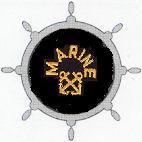
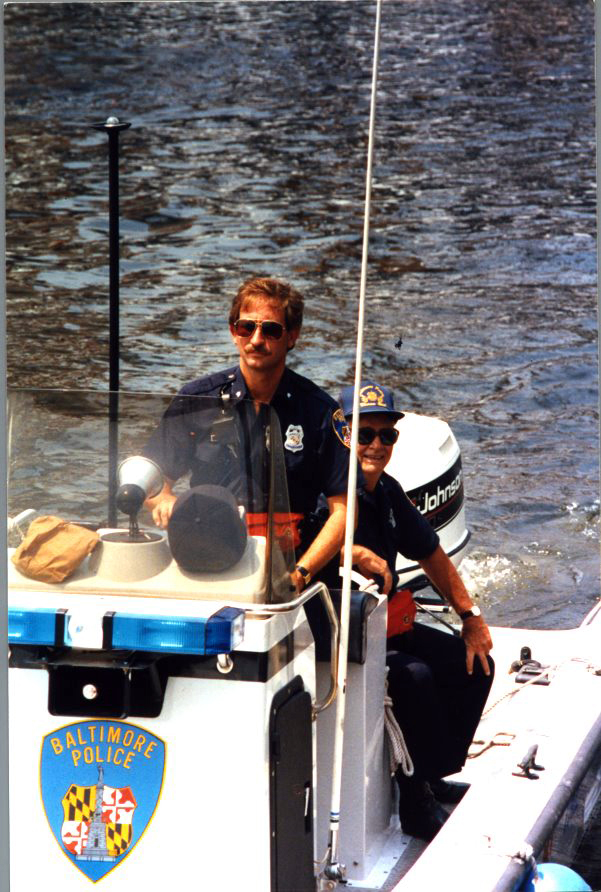
Courtesy Drew Hall
Drew Hall and auxiliary Officer Donald Bishoff
Marine Unit 2012
Marine Unit 2012
Marine Unit 2012
Marine Unit 2012
Marine Unit 2012
Marine Unit 2012
Marine Unit 2012
![]()
Patrolling Baltimore’s Harbor in a Police Boat
6 Sept 1925
Patrolling Baltimore’s Harbor in a Police Boat
CAPT. CAREY HAS SPENT 24 YEARS CRUISING “POST” TO FIND TROUBLE AND AID IN DISTRESSED
Here’s a member the Baltimore police force whose post covers 11 and three 10 mi.² and to never walk a block while patrolling it. It is the largest “beat” in the city and not even a half square of footwork is involved in covering it. In this and various other ways, it is unique. The average “cop’s” life is quite different. In the downtown district, a man who has the job of maintaining law and order often has a shorter distance is two squares to patrol and sometimes he takes an hour to cover this be. But he is walking pretty much all the time. The stops are when he must investigate something a little unusual or when someone of the residents or businessmen waylay him to consult him about a condition or situation that lies in his path of duty or interest.
OUTLYING BEATS LARGER
In the outlying districts sometimes, the beat covers as large an area as 2 mi.². In this case, he is given a longer time to patrol his distance. In all cases, the man working the post reports at stated intervals to his superiors from certain given points. The length of time given a man to cover a certain district depends upon the type of district. For instance, one man may cover two squares in our and another will cover as much as 16 blocks at the same time. At police headquarters, the average post in the city is said to be six square blocks, and the man covering this area usually is given an hour to make the trip. For instance, on the plate in the inspector's office, there is a post bounded by Broadway, Washington, fleet and Bank streets; as this is considered an average post. Baltimore, Pratt, Broadway and Washington streets is still another average post. These both include six square blocks, and the men who covered the post are given an hour to get around. In two hours the average city cop, therefore, covers about eight squares, and, in addition, he has to patrol the small streets and alleys that intersect his district. And it’s all footwork.
NO FOOTWORK FOR HIM
But the man who has the largest beat doesn’t have anything of this sort to do. I’m watching the 11 and three 10 mi.² that make up his territory he doesn’t get the exercise that is part of the life of his fellow workers in the city. This policeman with a second job is Capt. Edward J. Carey, captain of the police patrol boat Robert Carter, which rides merely up and down the harbor at all hours of the day and night. It covers all portions of the harbor that are navigable, going up into Curtis Bay and the upper Patapsco section and down toward the bay as far as quarantine, where the city limit ends. 24 years patrolling Baltimore’s harbor is the record of Capt. Carey, who is in charge of this local Marine police force. Nowadays the port is rather peaceful but during those 24 years Capt. Carey has had a goodly share of adventure. And he has seen many changes take place. In former years, he recalls, there were many sailing vessels always within the harbor limits. Sometimes as many as 50 would be crowded together at anchor. Now the craft that travels under sale is something unusual, as most of the vessels of gasoline engines. There aren’t so many of the smaller vessels either as in the days gone by and is a freak carrying sailing schooners are becoming fewer and fewer.
MORE PEACEFUL NOW
This is one of the reasons why the harbor is a more peaceful place than in years gone by, says Capt. Carey. The gasoline boat needs only a few men to man her, and usually, the owner and one or two members of his family are sufficient. Formerly, when the sailing craft was in the majority, each vessel needed a larger number of men, and the men who “followed the water” in the capacity of semen in those days were not a particularly peaceful type. “Yes, they use the Shanghai them, and take them down on the oyster boats,” recalls the captain, “in there was a lot of complaints about that practice. The men said they were overworked, but I always doubted whether it was possible to overwork those husky toughs. Nowadays, when we nose in and out of the wharves, we keep our eyes open, but it isn’t often that we come across anything very serious. “Once upon a time we would likely to be called into a free-for-all fight at any time. Today when we get a call from a ship we seldom find anything serious the matter. Perhaps the captain has had a clock or a line of brass stolen. If a fight does start, as soon as we ride alongside the fighters become as meek as a lamb.”
OUTBREAKS OF THIEVERY
However, there is an outbreak of ship thievery every once in a while and then the police boat is kept busy. “In most cases.” Says Capt. Carey, in referring to this particular activity, “some members of the crew are responsible. When a Capt. Goza, sure he very often leaves a crew of which he knows nothing in charge, and upon his return he finds things missing. If there is too much missing the man who has committed to theft has gone also. “Ship thieves are most difficult to convict,” he continued, “as they generally know when the captain has his sailing orders. So they do their work the night before, and as a rule, if they are caught and come up for trial later on the captain has had to leave port and there is no one to testify against them. So they go free for lack of evidence. Usually, the thefts are so small that it doesn’t pay the captain to hang around until the trial.”
VARIETY OF CALLS
“We are asked to do all sorts of things,” says the commander of the patrol boat. “Every now and then some irritated gentlemen the downtown office, angry because of a boat in the harbor whistle’s, while he was talking over the long distance, sends in a demand that we make the boats stop whistling. “Then one of her duties is to recover dead bodies in the harbor. There are other jobs that furnished plenty of variety.” The policeman on the beat who plods the city streets comes to recognize everyone who is an habitue of the zone he protects. Sometimes he knows more about them than they ever suspect. In like manner Capt. Carey during his 24 years spent maintaining order in Baltimore Harbor has become familiar with every boat sailing the local waters and instantly recognizes the captains and crews.
KNOWS “HOME BOATS”
Riding down the river aboard the Robert Carter the other afternoon to the city limit with the patrol boats beat stops and which is opposite quarantine, Capt. Carey gazed down the Bay. There was a two-masted schooner coming into the harbor and at a distance, it looked to be the Landsman little more than a toy ship. Apparently, there was nothing to distinguish it from a number of other two mass of schooners. “There comes the “Margaret,” remarked the captain “but you can’t tell it at this distance,” exclaimed the Landsman, “wait-and-see,” was the reply. A little later the schooner was close to the patrol boat. The captain was correct
RECOGNIZES MANY SHIPS
“You see,” he explained, “you get to know boats just as you get to know people you see every day. Even if they don’t come into port for some time, you don’t forget how much more than you would forget a friend who went away for a while and came back.” Capt. Carey is also a mine of historical data anent the various craft. Passing the William H. Parker, lying at one of the wharves, he remarked: “That boat has an interesting history. About 20 years ago she was wrecked off the coast of North Carolina and drifted all the way to the coast of Maine and then back again to the same locality where she was wrecked the entire trip being made in little more than the time she was taken to make it under sale. “She was a sailing craft in those days. She was salvaged and there she is today.”
KNOWS SHIPS HISTORIES
Capt. Carey is communicative as to the craft lying in the bay and their histories. He is also generous with information as to the points of interest in the harbor and if there is ever a “rubber neck wagon” established for those who wish to see Baltimore Harbor before viewing the broad Atlantic, the “spieler” first should take a course of instruction from Capt. Carey. But as to his own exploits and adventures as Capt. of the patrol boat, he is reticent. “He’s been in some type places,” you will hear about from friends, “he swims like a fish and doesn’t know what it is to be afraid of anything. When there’s trouble on board one of the boats in the harbor Hill rush right into the midst, no matter if it’s a good size riot. And he doesn’t want men under him who can’t swim and who haven’t plenty of Kurds.” “Well, I should be able to swim,” was the captains' modest reply when questioned as to his aquatic ability, “as I was born and raised in Ocean City, and when I was 19 years old I was a lifeguard down there. It’s against the rules to be a lifeguard before your 21 years old, but when I was 19 some people took out a boat and upset it, and I went out after them and brought them and their boat in. “So the job was offered me and I accepted with the understanding that I was to be made the head of the next lifeguard station opened in Maryland.
CAME TO BALTIMORE
“The next station opened in this district wasn’t and Marilyn, that in Delaware, and I thought as it was in the district I should have the appointment. But the head of the district told me he couldn’t put a Maryland man in Delaware as it was against the rules. As he had already broken one role by allowing me in the service before I was 21, I didn’t see why he couldn’t break another one, so I resigned and came to Baltimore.” As to the Kurds to which his friends prideful he refers, Capt. Carey shrugs his shoulders and waves the idea side. “Oh, most of the time, all you have to do is to steer the patrol boat alongside the craft where the trouble happens to be and it’s all over. Just the fact that the police boat is on the scene is enough to quiet things down. They don’t know whether you’ve got two guys or 50 men aboard and has a matter of fact you may have any number, as it takes only a couple of minutes to call into the district and have a bunch sent down to the help with any job that threatens to be difficult.” The crew of a patrol boat in peace times consists of five men and strut. The latter isn’t on the payroll, but she never misses a trip was Capt. Carey.
STRUT KNOWS THE RIVER
Strut, it may be said, is in Airedale, and knows her river well. For instance, one of the ship keepers stations on a trio of boats anchored in the river has in Airedale dog also. As a patrol boat was strut aboard makes its way down the river strut takes things easy, perhaps napping, or perhaps lazily viewing the scenery. But as she hears the home of that other dog she rises, goes to the very front of the boat and assumes a pugnacious attitude. Approaching the other K-9’s place of residence she barks ferociously. Naturally, the dog barks also, and defiance is waft from craft to craft. Evidently, strut believes that the other dog wants to come aboard, for it is with an expression of duty well done that, having passed the three vessels with her K-9 resident, she goes back to rest. She has prevented that strange dog from invading her domain. The sanctity of the home is still intact.
ONLY TRAVELS WITH CAPTAIN
Strut never attempts to go aboard the patrol boat less Capt. Carey is in command, says her proud owner. “If the lieutenant is taking the boat out,” he says, “she never moves, but just as soon as I say “let’s go” she assured to be the first aboard. The only time she’s ever missed was once when she had some puppies and hid them in the lumberyard. We couldn’t find her for her puppies, although we looked everywhere. “However, she was given to me by an airman, and she hadn’t forgotten him, and one day when an airship flew over the harbor strut heard the motor and came out of her hiding place. We were on watch and discovered her.” The strut is one of the best members of the crew at locating drowned people. “Very often,” says the captain, “she will locate a body before anyone else has seen it. Shall stand up and parked at some object floating on the water, and will know that we’ve got a job ahead of us.”
SEEKS SEA ON VACATION
It might seem that after spending the major portion of 24 years aboard a boat, a vacation would mean to Capt. Carey the opportunity to go mountain climbing. But it doesn’t, one holiday time comes around the commander of the Baltimore police patrol boat hurries off to Ocean City, his boyhood home, and prepares to enjoy himself. “Why not?” He smiles, “I love the water and wouldn’t be happy away from it. My father sailed a boat and my mother’s father followed the sea, so I think I must inherit a love of the water. I couldn’t have been happy in this job for 24 years if I had not been keen about a boat, and when I have a vacation I get back to the sea.” Which somehow suggests the story of the car conductor who spends his day off riding around in the cars.
TWO POLICE BOATS
Baltimore has two police boats is a Lannan, which has been in service since the 1800s, and which is a heavy launch of a tug type, and the Robert Carter, which has been in use since 1917 and which is a gasoline launch. However, as the local waters are as a rule peaceful, only one boat is in commission. At present, the Lannan is being overhauled and renovated.
“Keeping order in the harbor” is the general duty of the patrol boat, but the phrase embraces a variety of jobs. For instance, if there is any trouble on board one of the craft is in the harbor, if a captain finds that his crew is growing pugnacious and beyond his control, he sends a call in the Eastern, Central, or Southwestern district. As Capt. Carey is in communication with headquarters every two hours he quickly is notified as to the need for his service. Or, if the captain of the ship sends out distress signals, the police boats quickly alongside.
According to the pilot rules of the United States government, a distress signal may be continuous sounding with any fault apparatus or firing gun, if in the daytime, and that night these signals with an additional flame “as from a burning tar barrel or oil barrel.”
FOREIGN SHIPS AIDED
If the trouble is on a vessel flying a foreign flag the responsibility of the patrol boat is the same as when the unpleasantness occurs on the home craft. The captain of the patrol boat cooperates with the commander of the vessel in distress.
A few weeks ago there was trouble on a ship with a Mohammaden crew, trouble that might be described as a mutiny. The patrol boat was called and later the difficulties were adjusted at the Eastern police station.
There are many laws governing Baltimore Harbor, enacted by both the federal government, the city of Baltimore and the state of Maryland. In exacting obedience to these laws the Police Department of Baltimore city, represented by the patrol boat and his crew, are active.
For instance, there is a city ordinance which says that “new material, refuse or matter of any kind shall be thrown into, deposited in or placed with the same may fall or be washed into the Patapsco River without the written permission of the harbor board,” and in carrying out this ordinance the police cooperate just as they do in the city where the housewife often is called to a conference with the policeman on the beat in which her home is located when she has been a bit careless about the way in which she deposited her garbage at the back of her gate.
MANY LAWS FOR PORT
And then there is another ordinance that is a trial to the small boys who, run from the habiliments of civilization, like to use the harbor as a swimming pool on warmer summer days. These youngsters keep a keen watch out for the police launch that is likely any minute to cite them as they give imitations of young seals.
In addition, there are many laws covering the use of the peers had wharves and Baltimore’s harbor – the loading and unloading of vessels; laws that have been drawn for the purpose of preventing fires; laws that safeguard the lives of the people who work or play around the local waters. For the infringement of these laws, the commander of the patrol boat keeps a wary eye open.
As in the city, the policeman is among those who were present when a fire breaks out at the water’s edge or aboard ship, and he cooperates with the fire department in the task of saving life and property.
Then there is the question of traffic regulation in the harbor and among the duties of the commander of the patrol boat of a traffic cop. Traffic on the water is regulated by signals, lights and buoys, and before a man is allowed to sail a ship or command of the vessel he has to convince Uncle Sam that he is capable of doing so. Traffic regulations are largely determined by the United States government.
COMPLICATED LIGHTS
For instance, in “an act to adopt regulations for preventing collisions upon certain harbors, rivers and inland waters of the United States” is found the following: “a steam vessel when underway shall carry: (a) on foremast, or if a vessel without a foremast, then in for part of the vessel, a freight white light, so constructed as to show an unbroken light over an arc of the horizon of 20 points of the compass, be fixed as to throw the light 10 points on each side of the vessel, naming only from right ahead to two points abaft the beam on either side, and of such a character as to be visible at a distance of at least 5 miles.”
This is only one rule, and there are dozens like it, concerning the display of white, green and red lights and their combinations. Even the lowly rowboat is not ignored by Uncle Sam who provides that at night it must “display a lantern showing a white light which shall be temporarily shown to prevent a collision.”
Then there are many rules as to whistles. To the layman reading these laws it would seem that on the water when in doubt, it is well to whistle, whether it is merely to keep up your own courage or to prevent some other craft rudely bumping you.
The matter of lights or whistles would seem most intricate, but the craft that is oddly related, or that does not observe any other water traffic laws, is immediately spotted by the police boast crew. A craft without lights is naturally under suspicion. In the report to the police commissioners made last year of the work of the patrol boat there is the item that properly valued at $29,310.20 was recovered through the activity of its crew. Other items record that during 1924 there were 40 arrests made, 13 dead bodies recovered and 40 dead bodies removed.
ACCIDENT CALLS TO
Removing sick or injured persons from the craft in the harbor is another job, and assisting vessels in distress is counted in the days work. Just as present in the stream there are several ships that have been discarded since the war and are lying idle with only a ship keeper on board. A few weeks ago the patrol boat was hailed by one of these keepers who wants to tell his troubles to a policeman, and he had real trouble. He was out of “grub.” A few days before some adventuring bootleggers, chased by their natural enemy, a rum runner, deserted ship and stock. The patrol boat crew had charge of the craft until it was taken over by the government agents.
Marine Unit 2012
Marine Unit 2012
Marine Unit 2012
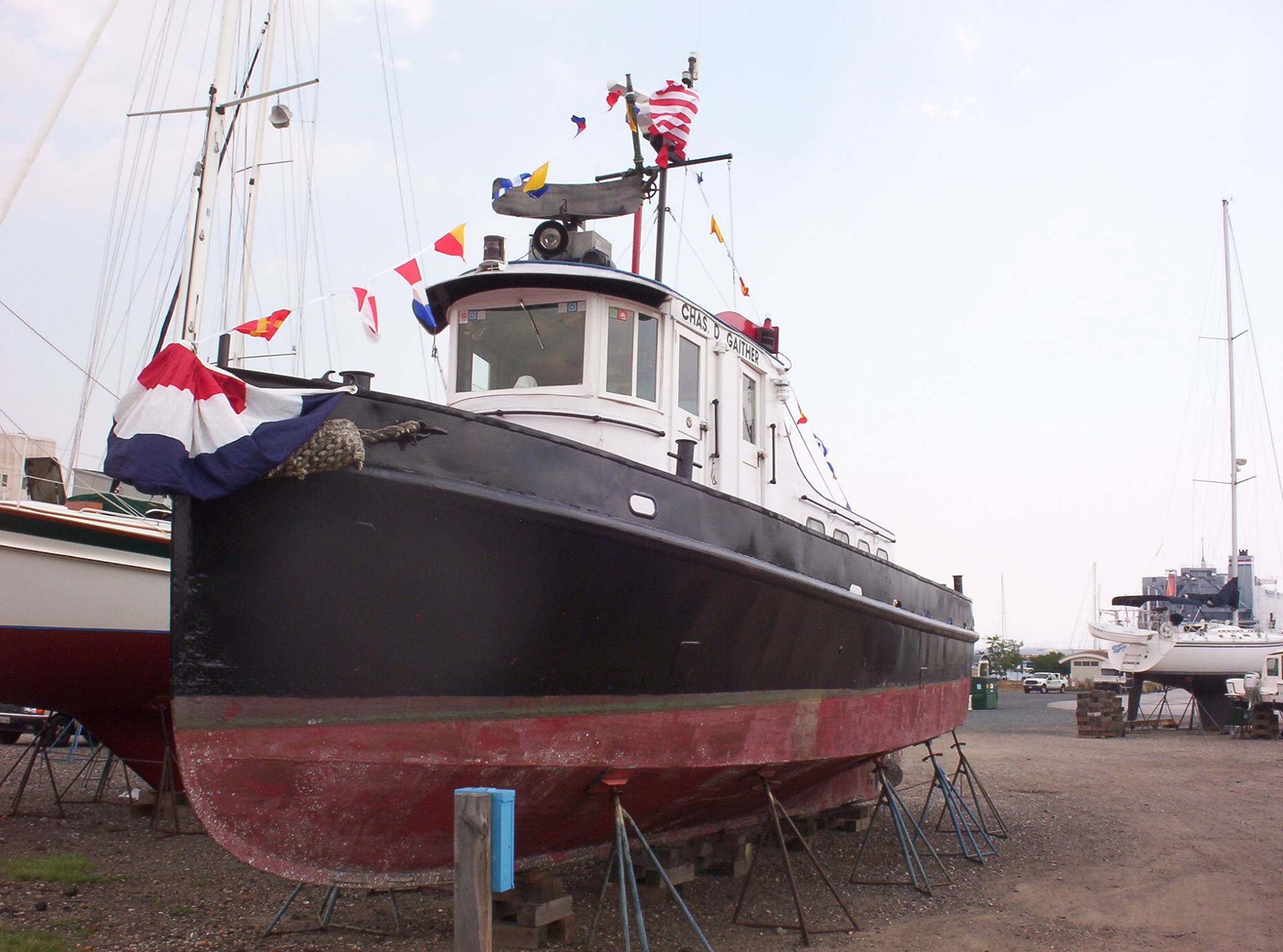
The Chas Gaither
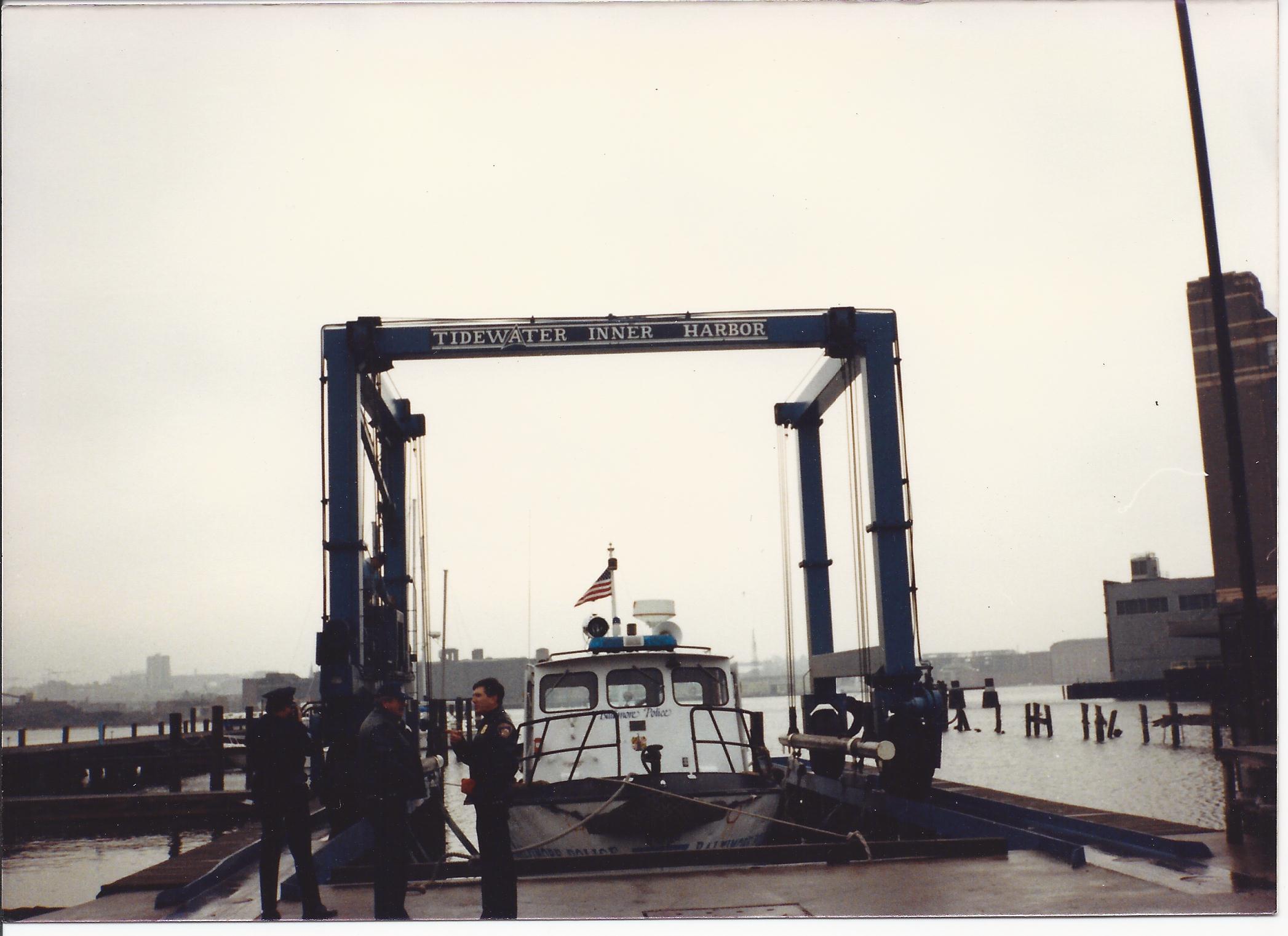
Courtesy Leonard J. O'Connor Sr.
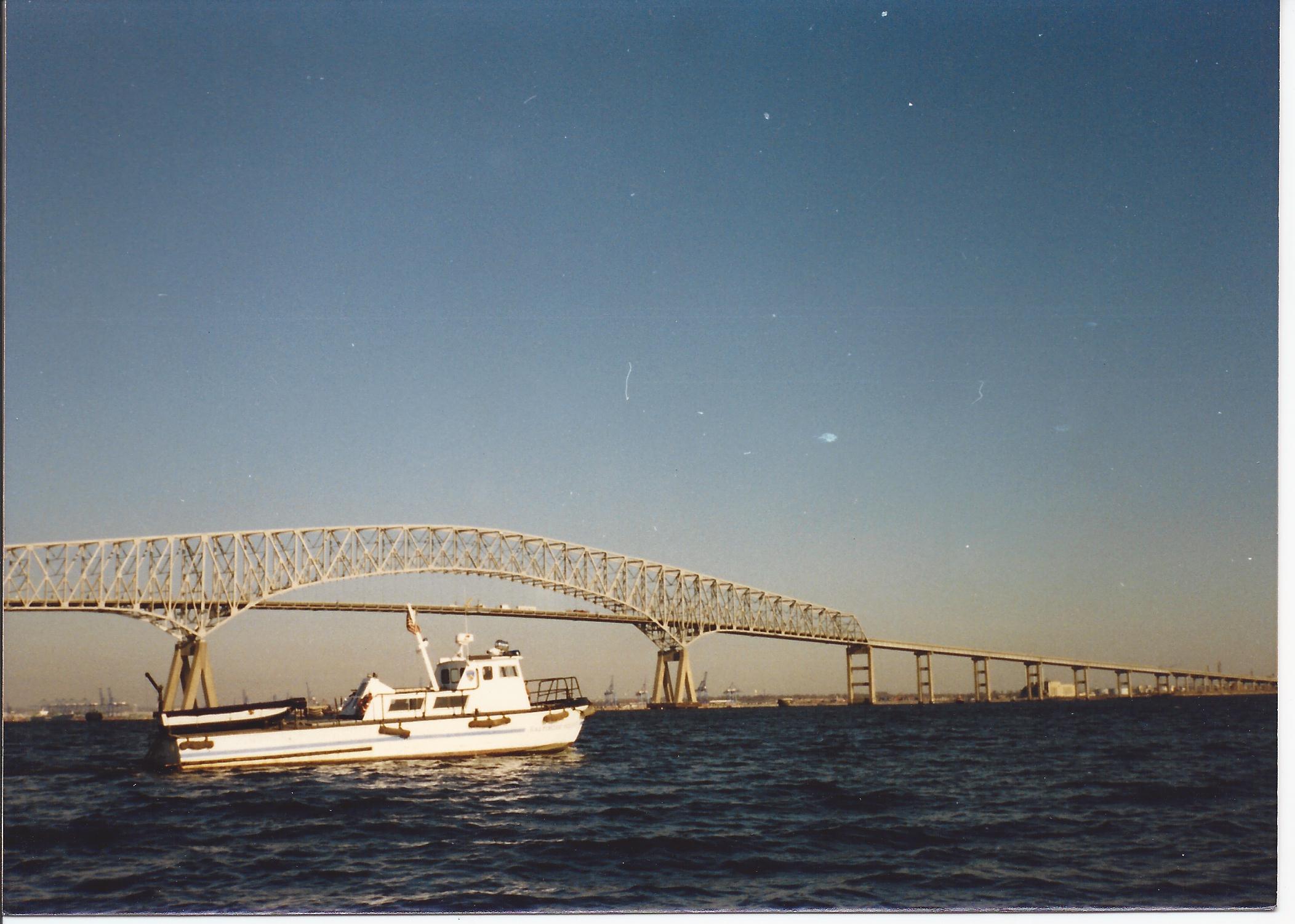
Courtesy Leonard J. O'Connor Sr.
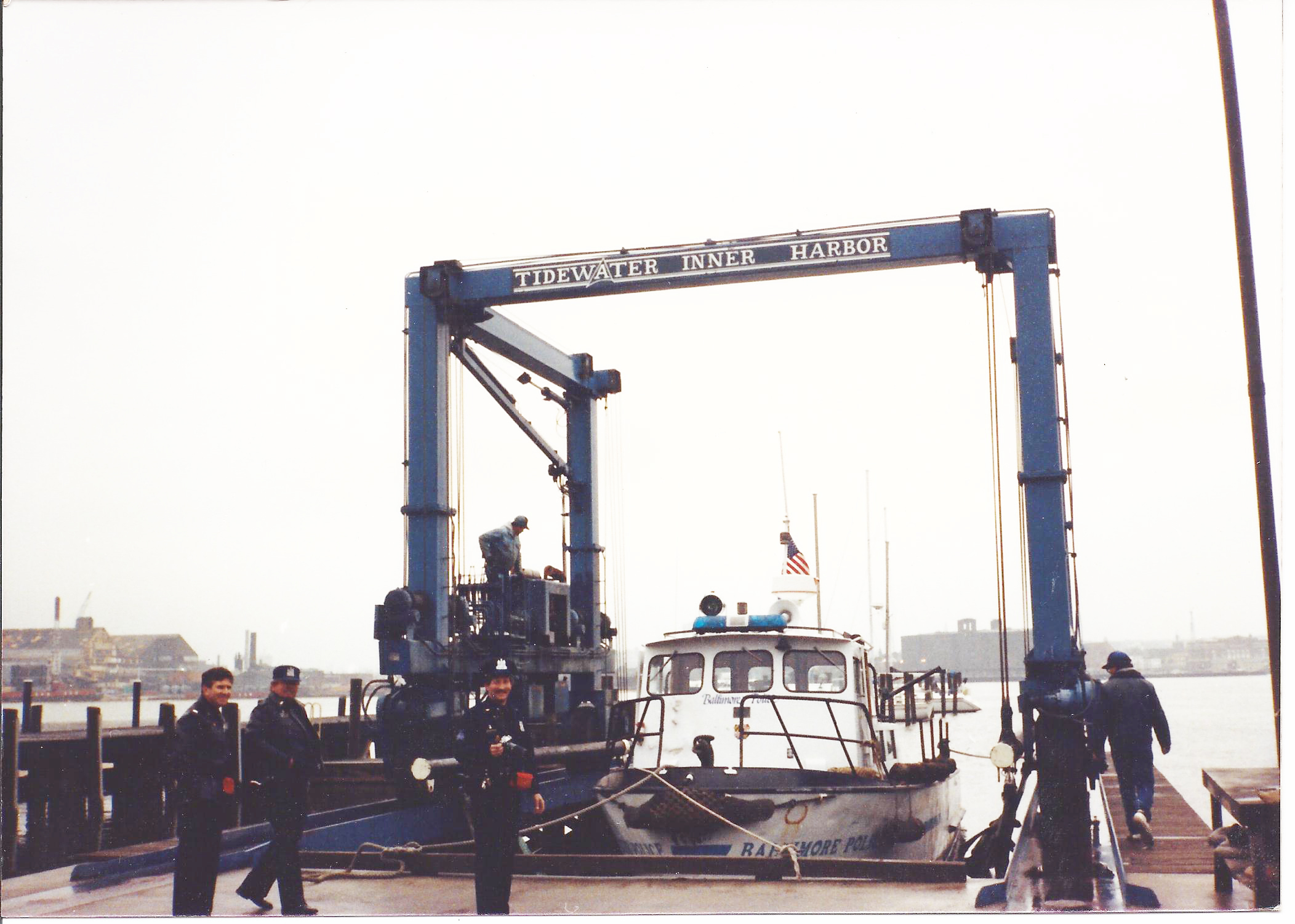
Courtesy Leonard J. O'Connor Sr.
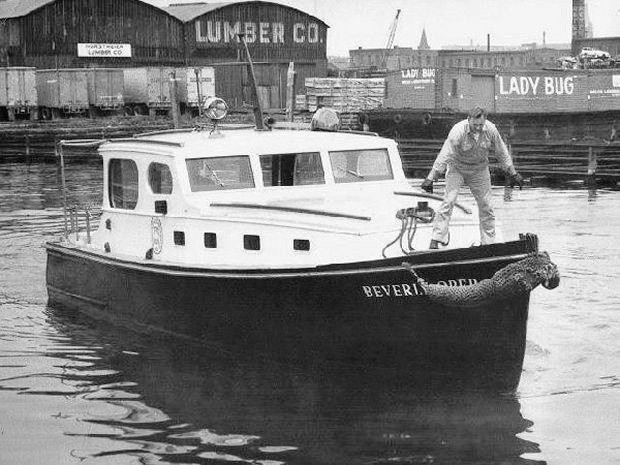
Courtesy Leonard J. O'Connor Sr.
Beverly Ober
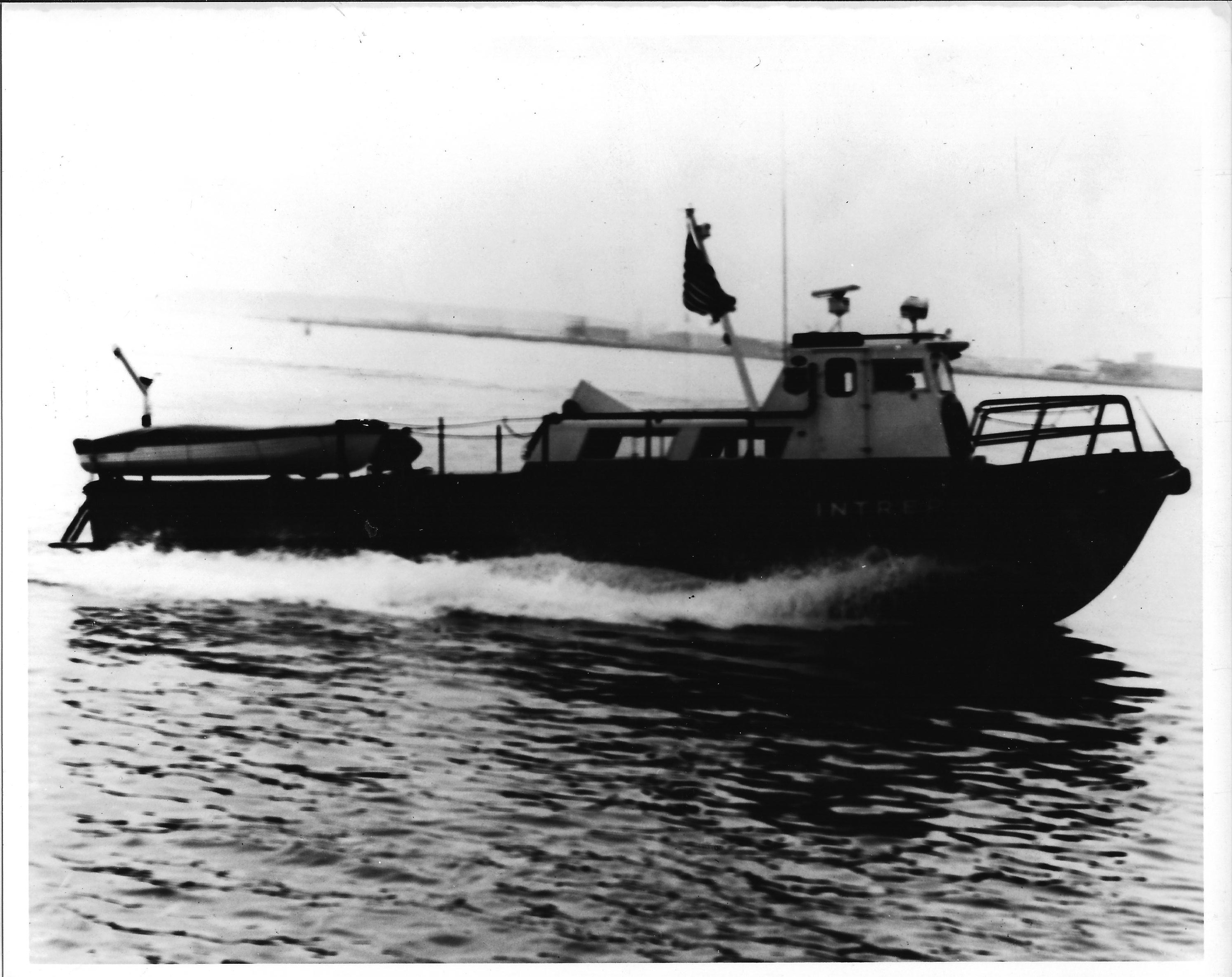
Courtesy Leonard J. O'Connor Sr.
Intrepid

BALTIMORE HARBOR PATROL OFFICER & PATROL BOATS OF 1907
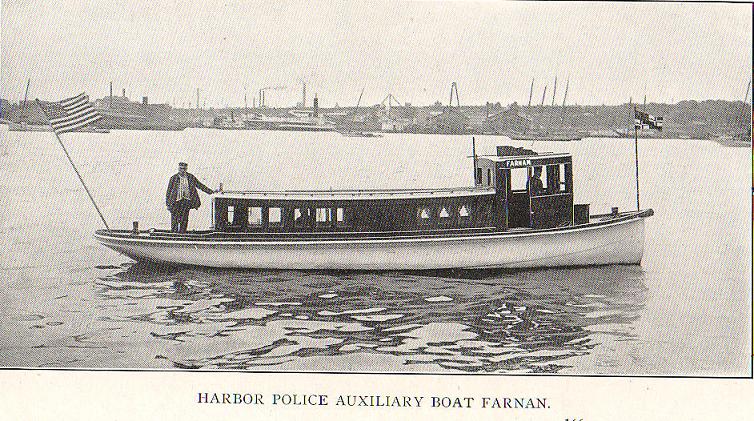
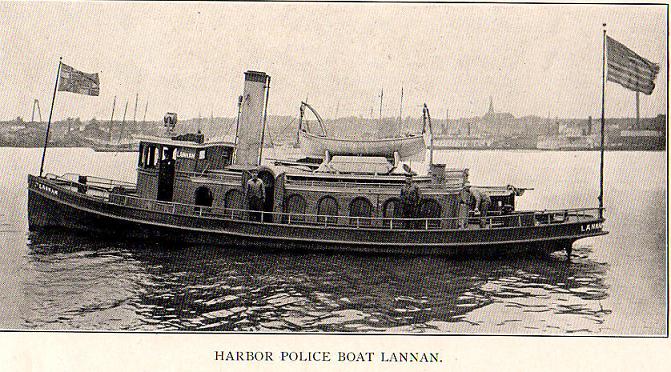
The Lannan 1891
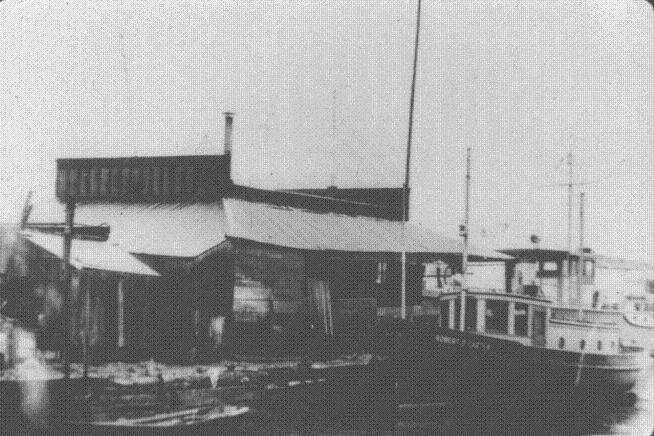
The "Robert D. Carter"
docked at the Marine Unit Station at the foot of Caroline Street

The police boat "Robert D. Carter" was commanded by Captain Harvey Von Harten

COURTESY OFFICER JAMES McCARTIN
‘NOTHING EVER HAPPENS’
Harbor Police Lead Quiet Life
By CLINTON H. JOHNSON
1937
The Plaint of the Harbor Police is
"Nothing Ever Happens."
Through long, lazy summer days, with the sun glinting on the harbor water outside their little station at the foot of Caroline Street, with nothing to break the silence but the waves slapping against the pilling of their pier--or through the long winter months, snug beside their stove in the station, or swinging their arms listily to keep warm as their trim craft plows its way along on one of its endless, aimless patrol cruises--through all their days and nights the same thought echoes in their minds: "Nothing ever happens."
Fleeting Fame
Their fellow members of the force get chances, now and then, to use their guns or their wits-or both-to gain passing front page fame and a place on the commendation lists. The harbor patrol squads read the stories, scan, the lists and sigh resignedly.
It never occurs to them that perhaps the reason nothing ever happens to them is that they're doing a thorough, efficient job. They read about harbor pirates in Boston, New York, and San Francisco and wonder why no gangs like that ever operate here.
They shouldn't have to look far for the answer. They themselves are the reason, And that's why, when someone asks Captain Harvey Van Harten, commander of the harbor patrol, to spin a yarn he grows fidgety and changes the subject. He knows what the public expects--a story of danger in the darkness of' the waterfront, of wily smugglers, daring thieves shanghaied scions, captive damsels. In short, Lime-house stuff.
That's what they want, he knows all too well. Being obliging by nature, he'd like to give it to them. But being also honest, he's sorry that he can't.
Under prompting, however, he may manage to dig up one tale from the more than 20 years he’s been patrolling the waterfront.
Mutiny Story
It's a story of mutiny--but as he gets that far the Captain raises a warning palm and tells you not to expect too much.
It happened, Captain Von Harten tells you, several, years ago. He goes on:
"I've "forgotten the name of the boat and the name of the skipper now. All I remember is that he was bound for Baltimore with a load of oysters from some port way down the Western Shore.
"He had a crew of five. Why in the world they ever decided to mutiny is beyond me, but mutiny they did. They got together and decided they were going to lock the skipper in his cabin and run the ship to suit themselves.
They walked aft to where the skipper was and told him they were taking charge of things. He gave ‘em an argument and one of the gang clipped him, not hard but just enough to show him they meant business. They weren't armed, but neither was he and they were five against one.
Turns Tables
They made him back up until he hit the cabin companionway, then back down to his cabin. They were going to lock him in. The skipper was so mad for those few minutes he hadn't been able to think, but as he was backing down the steps his mind began to work again and he remembered he had a shotgun standing right inside the cabin door.
When he got to the door he just reached behind him, got the gun and swung it up, to cover them. That turned the tables. The skipper climbed back up the companionway, making the crew back up as he advanced. He backed 'em right to the forepeak companionway and then made 'em go down into, the forepeak.
Once he got 'em in he locked the door quickly, piled a spare anchor against the door and then sat down to figure out what to do next.
Luckily he came within hailing distance of another inbound ship and shouted out for the skipper to send the harbor police out as soon as he could.
That's how we came into it. We got the message when the other ship got in and started out to look for the mutiny boat, We finally found her anchored over at the Canton flats. We went aboard, pulled away from the anchor and all the other stuff the skipper had piled on the forepeak door and hauled out those five mutineers. They were a sorry looking sight, too. The forepeak hadn't been too comfortable. Captain Von Harten shifted an easier position against the rail of the police boat, snapped what was left of his cigar off into the water and took a hitch at his belt, and that was the mutiny, such as it was. Remember I said it wouldn't be much. Nothing ever happens down here.
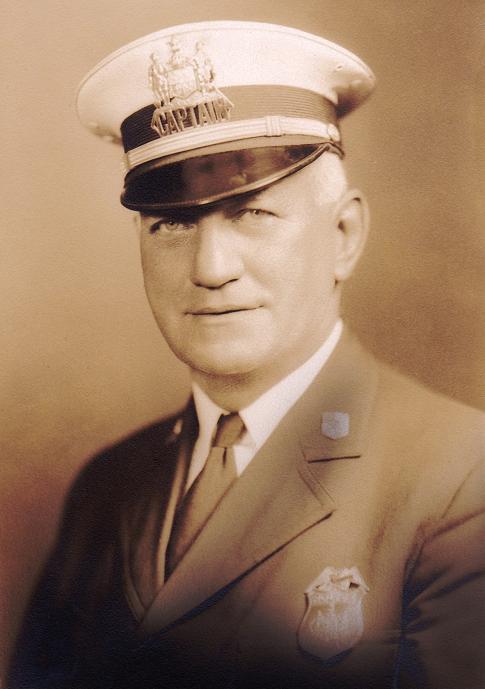
Photo courtesy of Mrs. Linda Hresko,.. Captain Harvey Von Harten's granddaughter
Captain Harvey Von Harten
1940

Photo courtesy of Mrs. Linda Hresko, Captain Harvey Von Harten's granddaughter
Standing (L-R) Officer Harry Langwhr, Lieutenant Welsh, Officer James Roach, Fireman Otto Thierfelder, Officer Charles Jullian
Photo courtesy of Mrs. Linda Hresko, Captain Harvey Von Harten's granddaughter
(L-R) Officer Charlie Juillan, Officer James Roach, Officer Ed Travers, Engineer Joe Meyers

Photo courtesy of Mrs. Linda Hresko, Captain Harvey Von Harten's granddaughter
(L-R) Officer Harry Langwhr, Officer Charles Juillan, Fireman Otto Thierfelder, Officer James Roach, Lieutenant Welsh
1940
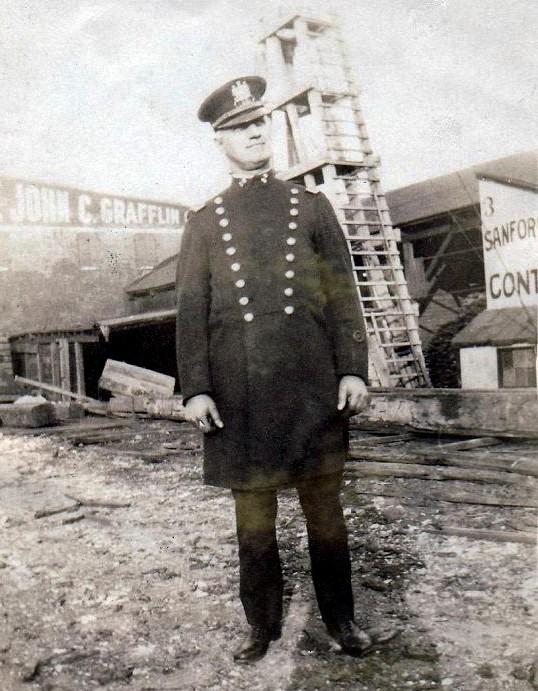
Photo courtesy of Mrs. Linda Hresko,... Captain Harvey Von Harten's granddaughter
Lieutenant Harvey Von Harten
1937

Photo courtesy of Mrs. Linda Hresko, Captain Harvey Von Harten's granddaughter
The "Christening" of the new police boat the "Charles D. Gaither" in 1940
Police Commissioner Charles D. Gaither in the light color suit stands to watch
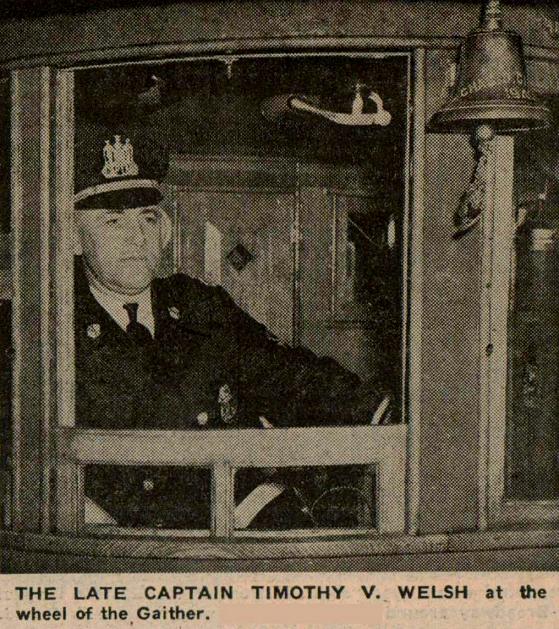
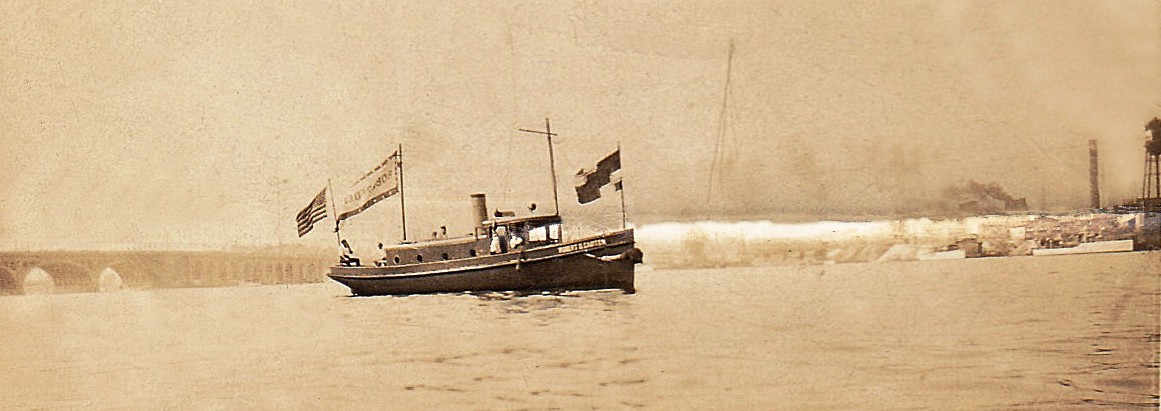
Photo courtesy of Mrs. Linda Hresko,... Captain Harvey Von Harten's granddaughter
The police boat "Robert D. Carter" Commanded by Captain Harvey Von Harten

Photo courtesy of Mrs. Linda Hresko,... Captain Harvey Von Harten's granddaughter
The crew of the Baltimore Police boat.
Captain Harvey Von Harten is the fourth officer (L-R)

VON HARTEN, 61, HARBOR CHIEF, DIES SUDDENLY
15 Jan 1941
Police Captain, Born in Tradition of the Sea, Suffers Heart Attack - Oldest Marine Division Member, Began Service in Southern District - Capt. Harvey Von Harten chief of the Baltimore harbor police, died of a heart attack yesterday afternoon 14 Jan 1941. At the age of 61, he was the oldest - member of the -department's marine division. He was said to be the only man on the force who was raised to the rank of lieutenant from that of patrolman. He received the promotion in February of 1921, two years after he joined the harbor patrol. Promoted to Captaincy In 1931 He was elevated to the captaincy of the harbor police ten years later, in December of 1931. Captain Von Harten was born and bred in the tradition of seafaring. The son of George Von Harten, proprietor of a seaman's hotel on Pratt Street, near Gay, Von Harten as a youth often listened to sailors from all parts or the world as they spun their tales in the little lobby of the hotel.
Went to Sea as Youth
These stories and a love of the sea he inherited from his family had their effect on him. While still a young man he went to sea, making trips to Europe as an ordinary seaman. When he returned to Baltimore and before he was appointed to the police force, he acted as skipper of the Sunbeam. Ferrying the late Edward P. (Admiral) Duffy, waterfront reporter for The Sun, from boat to boat in the harbor.
Began In Southern District
He was appointed to the force in. June 1911, and was assigned to the Southern District. In March 1919, he was transferred to the police boat. Captain Von Harten saw five police boats come and go and he commands three of them. The police boats Marshall Farnan and the Lannan were sold by the department long ago. Within the last year, the new Charles D. Gaither was put in commission to take the place of the George G. Henry. The Robert D. Carter still is in service.
Averted Trouble in Strike
One of Captain Von Harten’s favorite stories about policing came out of the Longshoremen’s strike here about six years ago. The strikers formed picket lines with boats along the harbor and it was the job of the water-front police to patrol these lines. One afternoon a group of longshoremen landed on a company dock. This was private property, the act was trespassing and Captain Von Harten knew there was sure to be trouble. He ordered his men to drag out the fire hose. In a few minutes, the dock was clear and trouble averted.
Arrests African American Male in Robbery
Early in his career, while .he was patrolling a beat in the Southern district, a storekeeper called to Von, Harten as he passed the establishment. He ran inside, the proprietor Screamed he was being robbed, and a large African American male who was standing in front of the counter offered no resistance as he was arrested.
Trouble was Not Long in Coming,
However Von Harten took him to a call box, and while they were waiting for a patrol wagon, the African Americn male whipped a butcher, knife out of his sleeve. In the struggle that followed, the African American male stabbed himself died. Von Harten was uninjured.
Uses Fireboats as Tugs
There was a big grain elevator fire at Locust Point about twenty years ago. The captain was fond of telling how during the fire the harbor police turned their boats to tugboat duty and pushed barges, loaded with freight cars full of grain, away from the piers to safety. Captain Von Harten was born in Baltimore and attended the public schools and the Polytechnic Institute. His first job was one of boiler worker obtained shortly after he left Poly. For several months he had been under physician's care for a heart ailment. He went on sick leave last November 14, but returned to duty December 9 and had been working regularly since that time.
Stricken in Front of Home
He died at 4.20 P. M., a few minutes after he left the police boat dock at the foot of Willis street. There he had told Lieut. Timothy Welsh, "I never felt better in my Life.” Patrolman Edward J. Travers drove the captain to his home at 3814 Echodale Avenue. Just as the automobile pulled up in front of the house, Captain Von Harten was stricken. Travers drove to the St. Joseph’s Hospital, where efforts to revive his superior for failed.
Received Numerous Awards
Twice during his career as a policeman, Captain Von Harten was commended for highly meritorious service of the department. He received numerous other awards. He is survived by his mother, Mrs. Ida Von Harten, of 1626 St. Paul Street, his wife, Mrs. Lottie Von Harten, one son, Harvey, Jr.
This new vessel was built for the Baltimore Police Department in 1956 by the Edwards Boat Co., in Middle River, MD. The 37’ 3” craft was constructed as an all wood Edwards Trunk Cabin Cruiser and was named in honor of the former Baltimore Police Commissioner Beverly Ober. It was constructed along the lines of a pleasure craft it was soon found to be unsuitable for marine police duty, and they planned on replacing it. Aware that the Fire Department Marine Division was in a jam, as their original tender boat had been scrapped due to rotting, the vessel was transferred over to the Fire Department at no cost in 1959, and placed in service on August 7, 1959, as the Marine Battalion Chiefs new command and inspection boat. The home movie has a wealth of now documented information about the Baltimore City Police Department. The film not only shows the new boat with police lights and a very large Federal siren and the BPD shield, it has pictures of the dignitaries from the Baltimore Police Department, the US Navy and Coast Guard. It clearly shows them, as they came to observe this new vessel being placed in service to patrol Baltimore’s waterways. The film shows the inner harbor and the many other ships that were in the process of unloading cargo and Baltimore’s industrial growth.
You see Lieutenant John Younger, pilot the boat and other members of the unit, patrolling the harbor. It shows some Baltimore Police Officer walking around wearing the old style badge and the old “rocker” shoulder patch. It shows the large black Buick or Pontiac that was the Police Commissioners car. There are 1950’s BPD vehicles bearing the old, old door shields. You actually get to see all this, as it happened some 53 years ago. The people actually walking around and the police vehicles as they drive to the event. You get that feeling of seeing the action that still pictures cannot give. Lieutenant John Younger retired from the Marine Division in 1973 and he and his wife passed away in 1998 eleven days apart. Thanks Mary for your donation to preserve the history of the department and honoring those who have served. Unfortunately, the film is too large of a file to present here on the site.
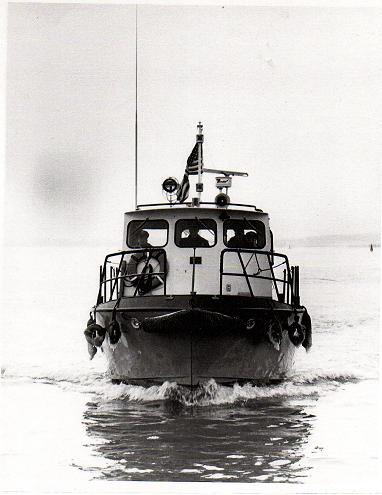
Baltimore Police Patrol Boat
The Beverly Ober was built in 1956 by the Edwards Boat Yard, Middle River, MD, for the Baltimore City Police Department as a harbor patrol boat. It was named after a former Police Commissioner. Constructed along the lines of a pleasure craft it was soon found to be unsuitable for marine police duty, and they planned on replacing it. Turned over to the Baltimore Fire Department in 1959 and outfitted as a Fire Boat.
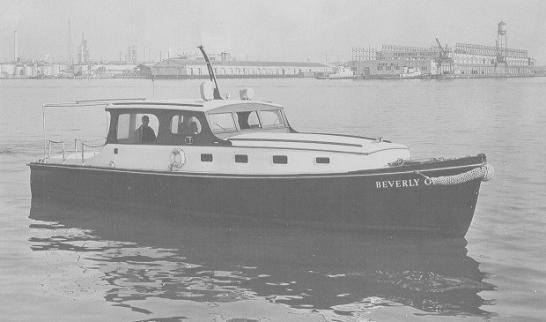


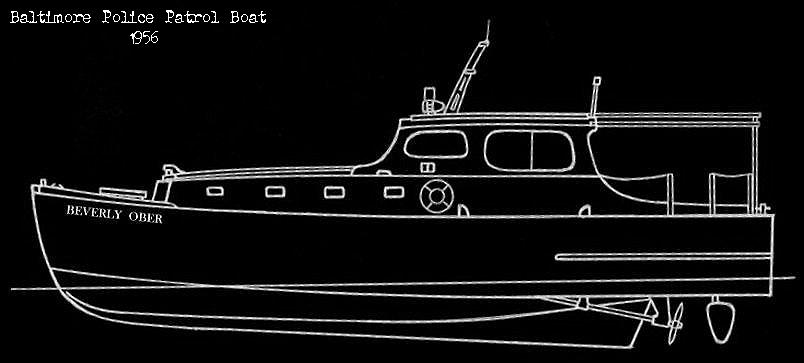
Classed as an Edwards trunk cabin cruiser, the characteristics of the tender boat Beverly Ober are as follows: Builder – Edwards Boat Co., Middle River, MD. Commissioned – ( by the Police Department, 1956 ) by the Fire Department – August 7, 1959 Cost - ( $22,000 Police Department ). transferred over to the Fire Department at no cost Official Number – 271230 Construction - all wood Length overall - 37 feet 3 inches Beam - 11 feet 9 inches Depth of hull - 4 feet 8 inches Full load draft - .?. feet Tonnage - 11 Net, 16 Gross Fuel capacity - .?. gallons of gasoline Maximum speed - .?. m.p.h. Propulsion - twin screw, two (2) Chrysler Marine, Type 104, 6 cylinder in-line, freshwater keel cooled gasoline ------------------engines, rated 125 H.P. each
![]()
The Following 14 Pics came to us courtesy of retired Lieutenant Robert Wilson


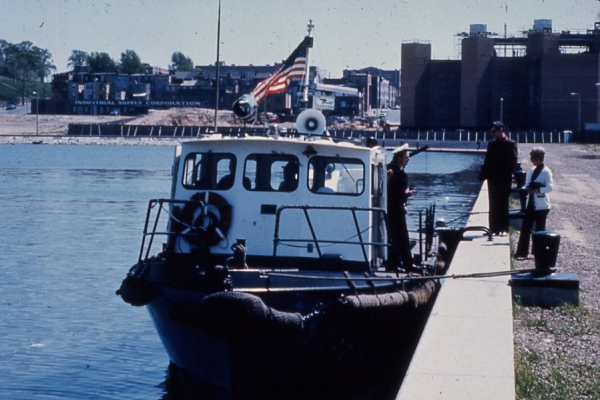

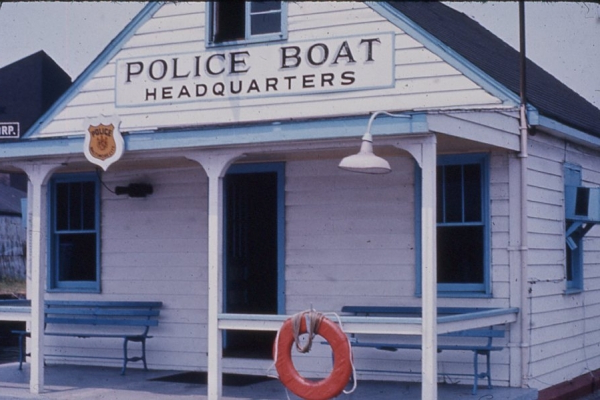
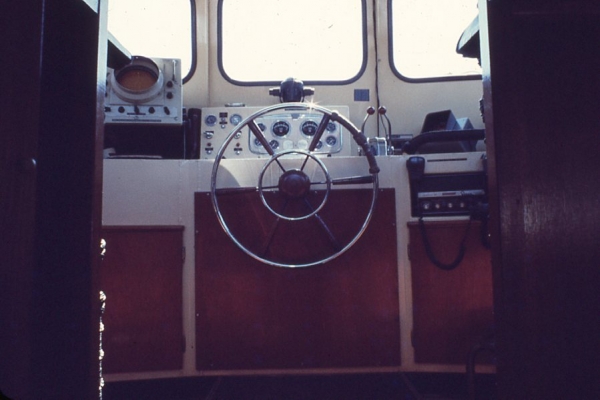
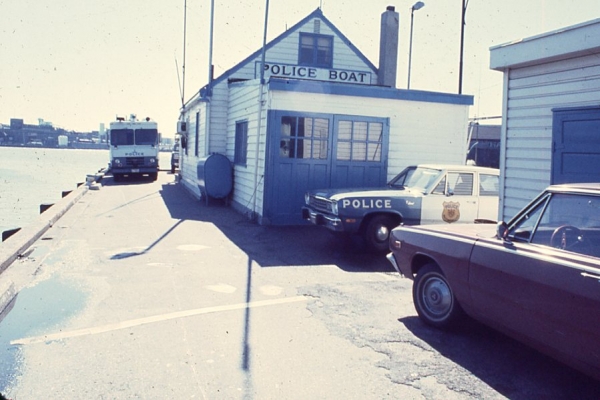
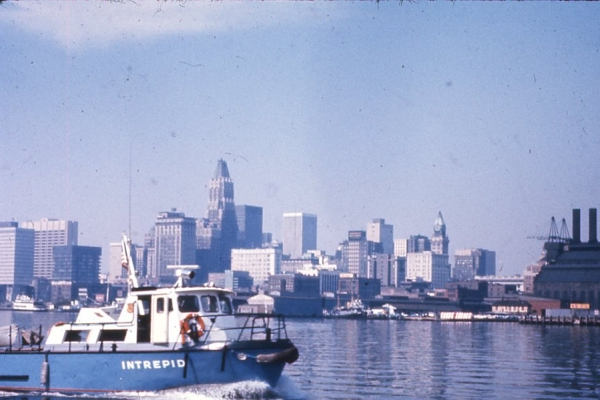
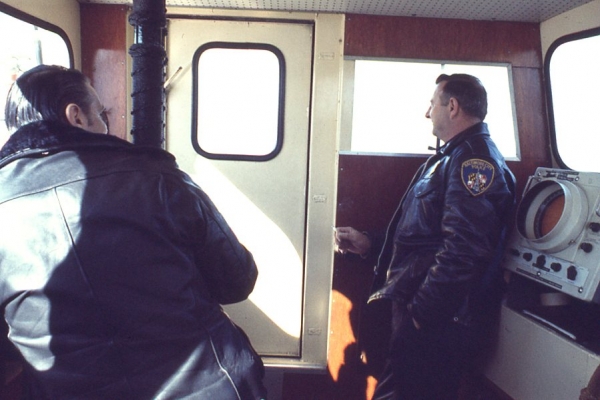


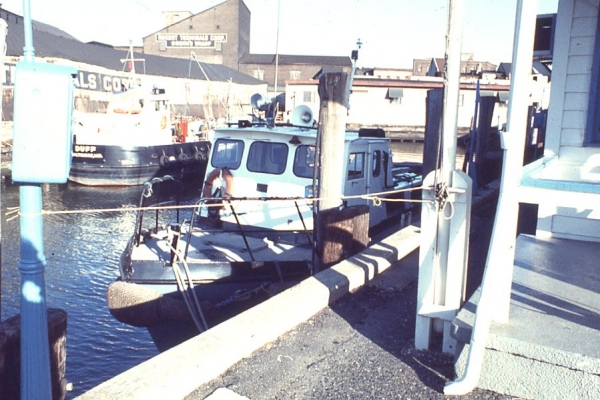


Baltimore Police Underwater Recovery Team Respond to Tragic mid-air collision on January 29, 2025
On January 29, 2025, a tragic mid-air collision occurred over the Potomac River near Ronald Reagan Washington National Airport, claiming the lives of all 67 people on board. The accident involved an American Airlines regional jet and a U.S. Army Black Hawk helicopter.
In the wake of this disaster, the Baltimore Police Department's underwater search and rescue team demonstrated exceptional bravery and dedication. Responding swiftly to the scene, the team worked tirelessly to recover victims and provide support to the affected families. Their efforts were instrumental in the recovery operations, ensuring that every possible measure was taken to honor the victims and recover evidence to support the ongoing investigation.





The Baltimore Police Historical Society Department proudly recognizes the heroic actions of its search and rescue team. Their unwavering commitment to duty and compassion in the face of tragedy exemplifies the highest standards of public service.
![]()
POLICE INFORMATION
Copies of: Your Baltimore Police Department Class Photo, Pictures of our Officers, Vehicles, Equipment, Newspaper Articles relating to our department and or officers, Old Departmental Newsletters, Lookouts, Wanted Posters, and or Brochures. Information on Deceased Officers and anything that may help Preserve the History and Proud Traditions of this agency. Please contact Retired Detective Kenny Driscoll.

NOTICE
How to Dispose of Old Police Items
Please contact Det. Ret. Kenny Driscoll if you have any pictures of you or your family members and wish them remembered here on this tribute site to Honor the fine men and women who have served with Honor and Distinction at the Baltimore Police Department. Anyone with information, photographs, memorabilia, or other "Baltimore City Police" items can contact Ret. Det. Kenny Driscoll at
Copyright © 2002 Baltimore City Police History - Ret Det Kenny Driscoll



